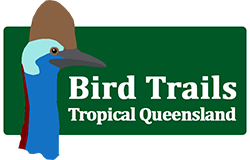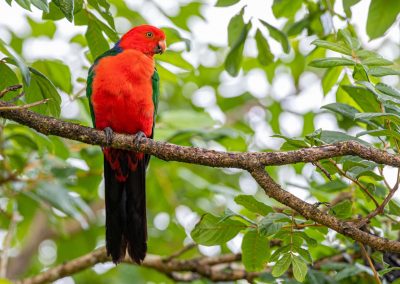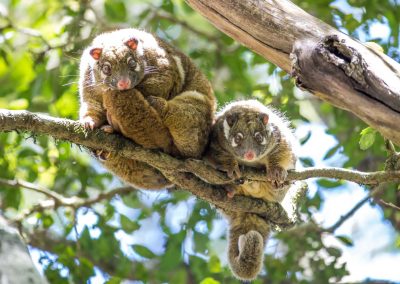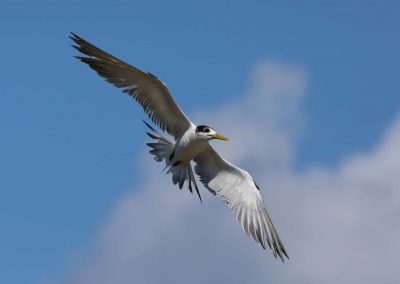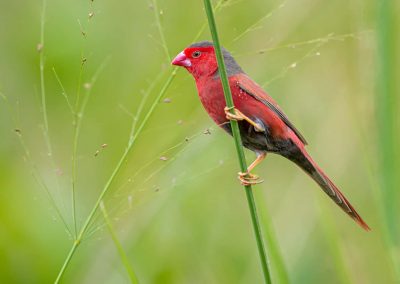Local ‘Top 50’ BirdFinder
This page is designed to give you more information about the most sought-after ‘Top 50’ birds of the Wet Tropics.
Below you will find species accounts for each of the ‘Top 50’. In these species accounts you will find some ecological information and some tips on finding them, including good sites to visit and good places to stay to increase your chances.
We have been so bold to list our ‘Top 50’ in order of ‘desirability’ based on the level of excitement that bird engenders in the usual birder visiting our area for the first time. The order or ranking of our birds is, of course, very subjective and depends on a great number of variables, most notably whether a person has seen that species before and what weight is given to endemic species.
This guide is designed to be used in conjunction with the Tropical North Queensland Bird Trails brochure. A pdf of the Wet Tropics ‘Top 50’ BirdFinder is also available.
Where possible I strongly encourage the use of any of our excellent bird guides to help you more quickly locate the special birds of the Wet Tropics.
Top 10 ‘Most Wanted’ Birds
Southern Cassowary, Golden Bowerbird, Buff-breasted Paradise-kingfisher, Blue-faced Parrot-finch, Victoria’s Riflebird, Lesser Sooty Owl, Tooth-billed Bowerbird, Chowchilla, Fernwren, Pied Monarch.
Descriptions, Best Sites, Accommodations
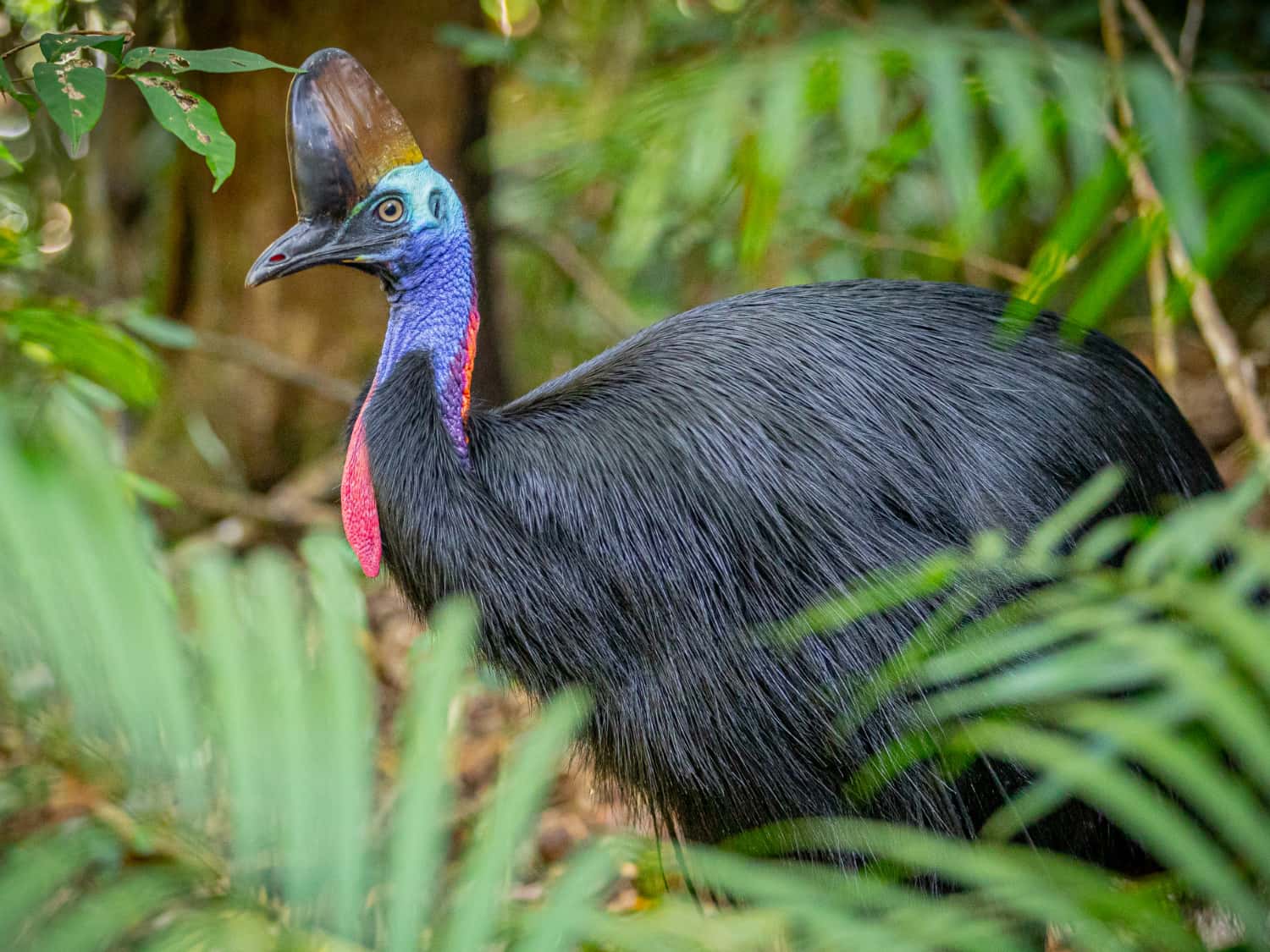
© Dom Chaplin
1. Southern Cassowary Casuarius casuarius
Resident. Endangered. Rainforest. Coastal lowlands to high altitude. Year-round. Flightless ratite. In Australia, confined to the tropical rainforest of North Queensland. Approach with caution. Males usually nest in the winter and are a little less visible at that time. Probably a little more likely in the early morning or late afternoon as they may sit down during the middle of the day for a siesta. May be found foraging along rainforest roads and carparks feeding on rainforest fruit particularly Blue Quandong and Cassowary Plum. Both males and female cassowaries have a deep booming call that can be heard 200-300 metres away. Free-ranging wild cassowaries often frequent gardens of rainforest accommodations. Best Sites: Jindalba Boardwalk, Black Mountain Rd, Mt Hypipamee NP, Etty Bay, Lacey Creek. Accommodations: Cassowary House, Atherton Tablelands Birdwatchers’ Cabin.
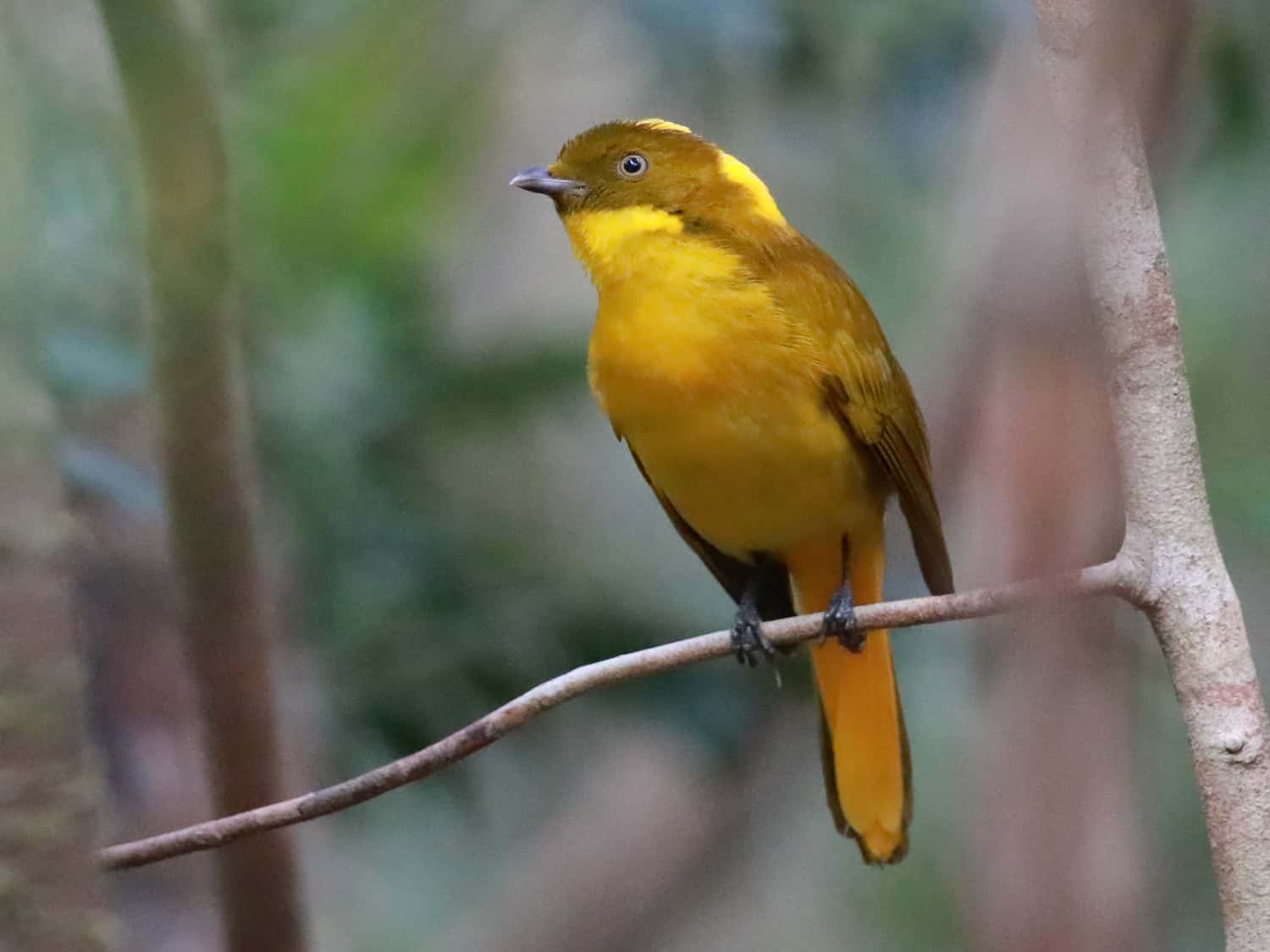
© Birdwatching Tropical Australia
2. Golden Bowerbird Amblyornis newtonianus
Wet Tropic endemic. Uncommon. Rainforest. High altitude. Spring & summer. Highly sought-after, predominantly ‘yellow’ small bowerbird with incredible maypole bower. Occurs in rainforest above 900m. Can be difficult to find. Should be attending bowers between June to December. When active they should visit the bower every 10 to 20 minutes, at other times they may be sitting quietly in the mid-canopy almost overlooking the bower. If not at the bower can sometimes be found foraging for fruit high within rainforest. Females and young males are olive-brown and less obvious than adult males. At the bower, males have a series of incredible calls including frog-like croaks and metallic rattles. Best Sites: Mt Hypipamee NP, Mt Lewis. Accommodations: No accommodations have this bird regularly on site.
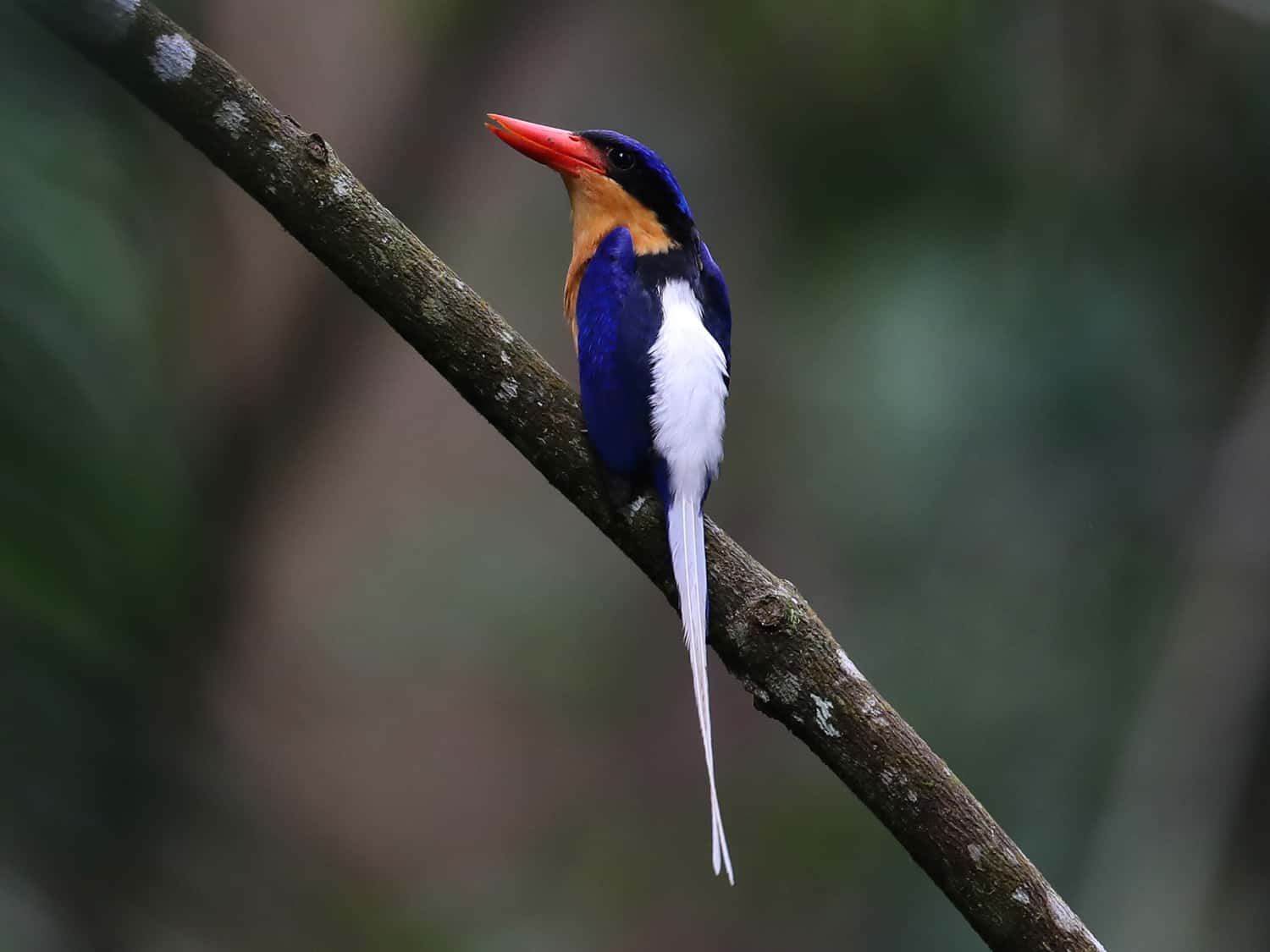
© Birdwatching Tropical Australia
3. Buff-breasted Paradise-kingfisher Tanysiptera sylvia
Summer migrant. Locally common. Rainforest. Coastal lowlands to mid altitude. Spring & summer. Stunningly-coloured kingfisher with red bill and white tail streamer. First sighting is often a flash of its white tail as it flies. Usually perches in the mid to low canopy. Sometimes can be spotted by the movement of its white tail up and down as it calls. Arrives from Papua New Guinea in late October or early November. Nests in distinctive round termite mounds on the rainforest floor on metamorphic soils before departing in late April to spend the winter in PNG. Distinctive ‘quill, quill, quill’ call. Best Sites: Stewart Creek Rd, Jindalba Boardwalk, Mt Lewis (base), Mowbray NP. Accommodations: Sweetwater Lodge.
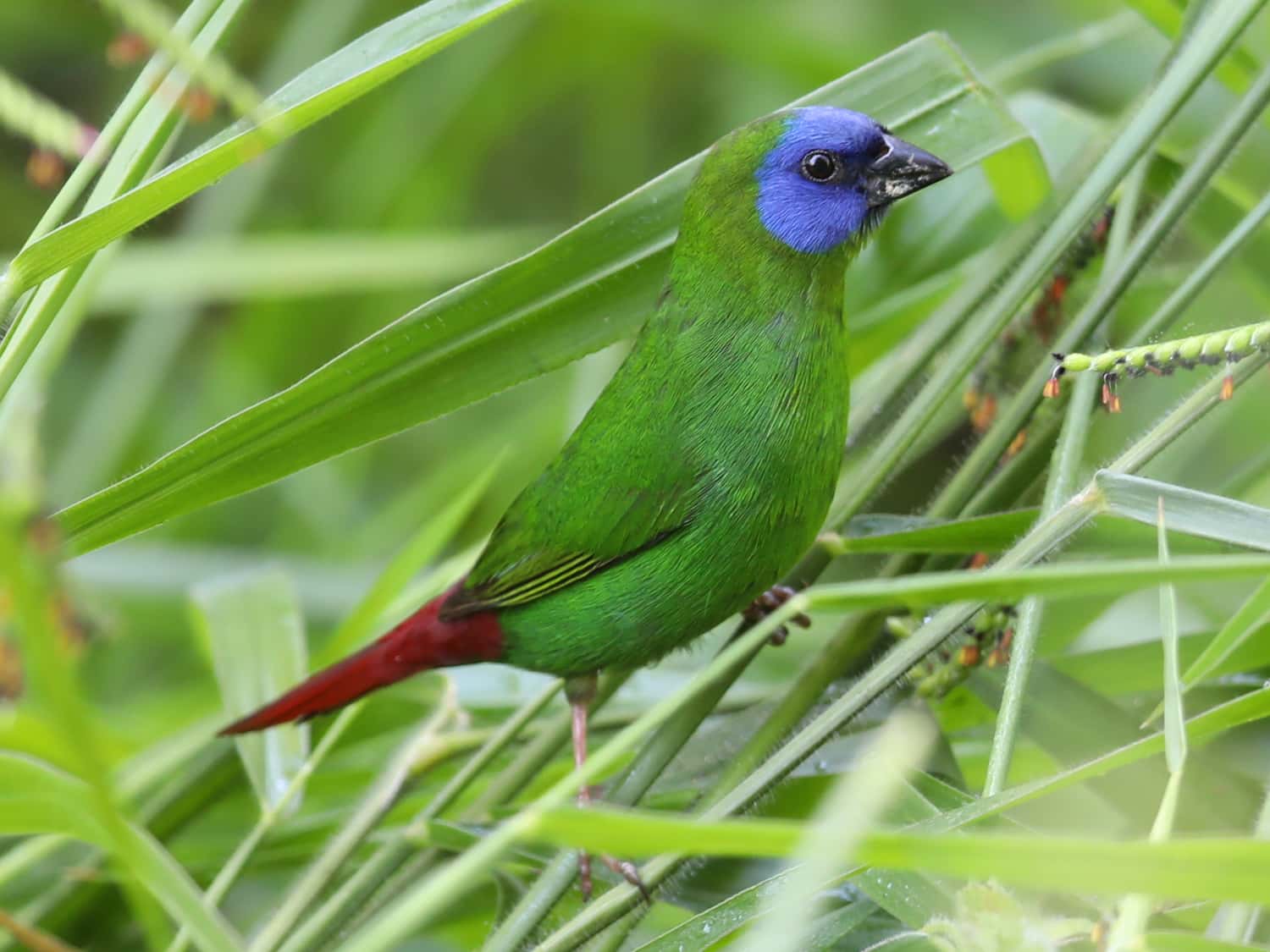
© Birdwatching Tropical Australia
4. Blue-faced Parrot-finch Erythrura trichroa
Seasonal altitudinal nomad. Uncommon. Grassy clearings. All altitudes. Easier in summer. Colourful finch related to the Gouldian Finch. Feeds on the seeds of long grass. Spends cooler months at lower elevation before moving to higher elevations in summer. In winter, it may be found on lower grassy clearings on Mt Lewis, and surrounding roads. In summer, they may be found higher clearings on Mt Lewis and along rural roads east of Mt Hypipamee. May sometimes be found foraging with other finches. Call is a high-pitched double note twittering easy to miss. Best Sites: Mt Lewis. Accommodations: Sweetwater Lodge (best April-July).
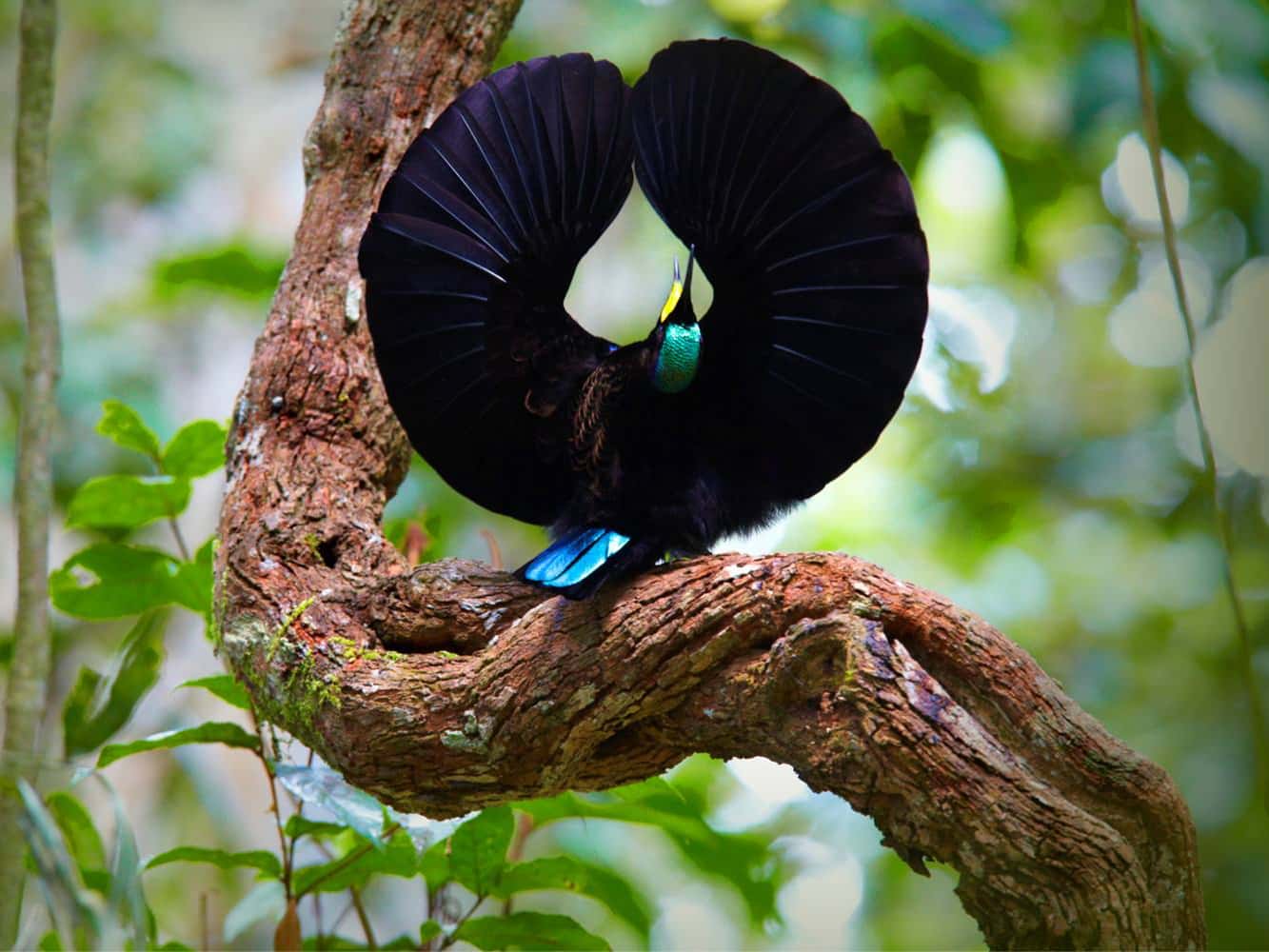
© Alan's Wildlife Tours
5. Victoria’s Riflebird Ptilotis victoriae
Wet Tropic endemic. Uncommon. Rainforest & woodlands. Mid to high altitude. June to November. Bird of Paradise family. Difficult to find resident. Occurs in rainforest above 400m. From about June adult males display at regular ‘posts’ during the breeding season. Display posts are usually prominent positions within the forest particularly vertical snapped tree trunks or similar. May be heard flying on ‘heavy’ wings, emitting an airy sandpaper-like noise. Call is a loud distinctive rasping ‘yaass’. Best Sites: Mt Lewis, Black Mountain Rd, Crater Lakes NP, Goldsborough Valley, Jindalba Boardwalk. Accommodations: Cassowary House, Crater Lakes Rainforest Cottages, Atherton Tablelands Birdwatchers’ Cabin.
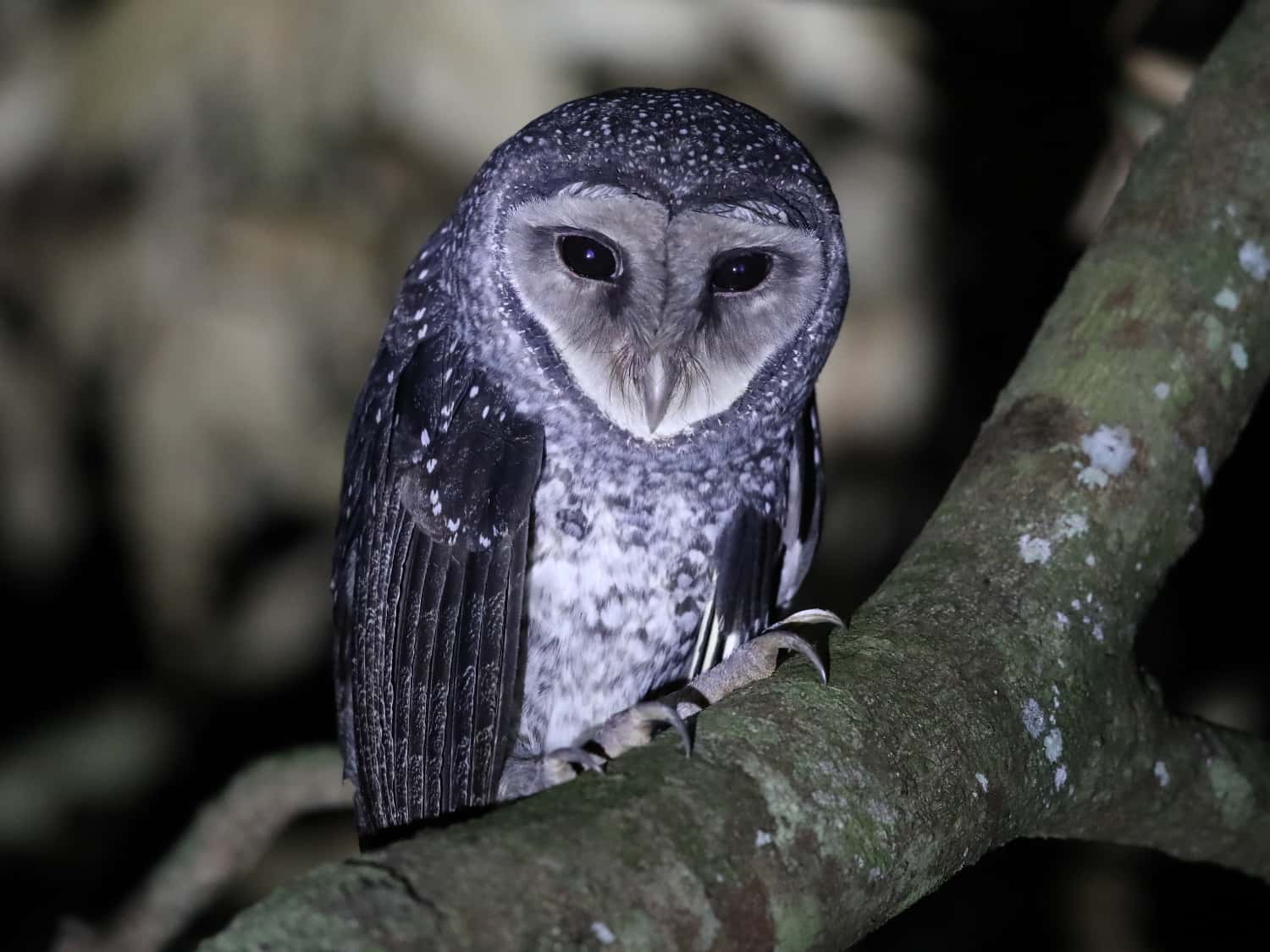
© Birdwatching Tropical Australia
6. Lesser Sooty Owl Tyto multipunctata
Wet Tropic endemic. Uncommon. Rainforest and eucalypt forest. All altitudes. Year-round. Sooty grey owl with distinctive falling bomb call, trills and screams. Difficult to find. Best Sites: Mt Lewis, Black Mountain Rd, Hypipamee NP, Curtain Fig NP, Crater Lakes NP. Accommodations: Cassowary House, Crater Lakes Rainforest Cottages, Sweetwater Lodge.
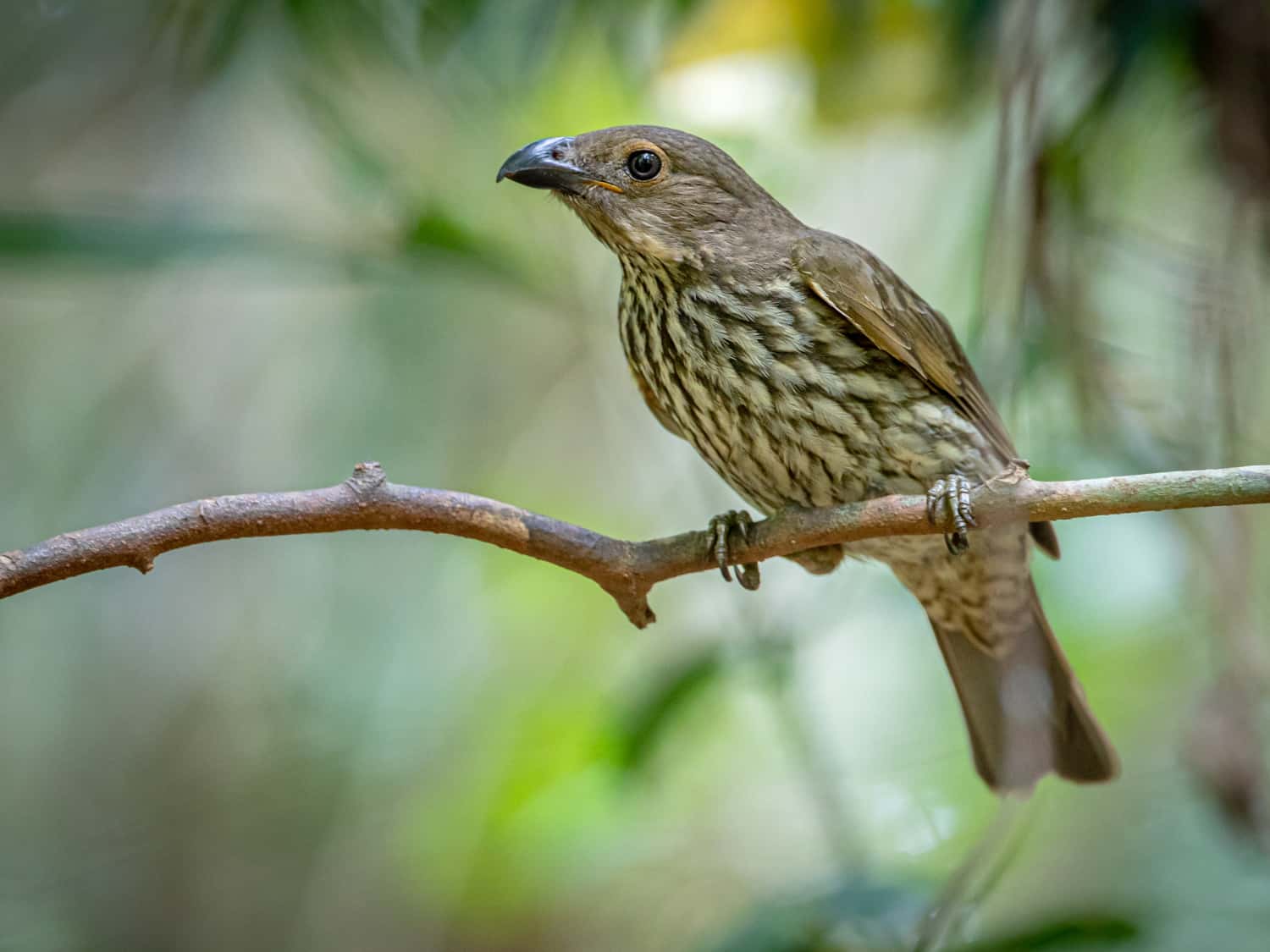
© Dom Chaplin
7. Tooth-billed Bowerbird Scenopoeetes dentirostris
Wet Tropic endemic. Locally common. Rainforest. High altitude. Easiest June to December. Quiet and difficult to find for the first half of the year. From late August, males create ‘display courts’ and often sit a few metres above calling loudly including the harsh mimicry of other bird species. Mimicked calls include King Parrot, Crimson Rosella, Mountain Thornbill, Bridled Honeyeater, Bower’s Shrike-thrush. Display courts are an area of rainforest floor (several square-metres) cleared of debris with large green leaves placed upside-down. At non-breeding times they can sometimes be observed high in the canopy foraging for small fruit. Best Sites: Mt Lewis, Mt Hypipamee NP, Curtain Fig NP, Wongabel SF, Crater Lakes NP. Accommodations: Crater Lakes Rainforest Cottages, Atherton Tablelands Birdwatchers’ Cabin.
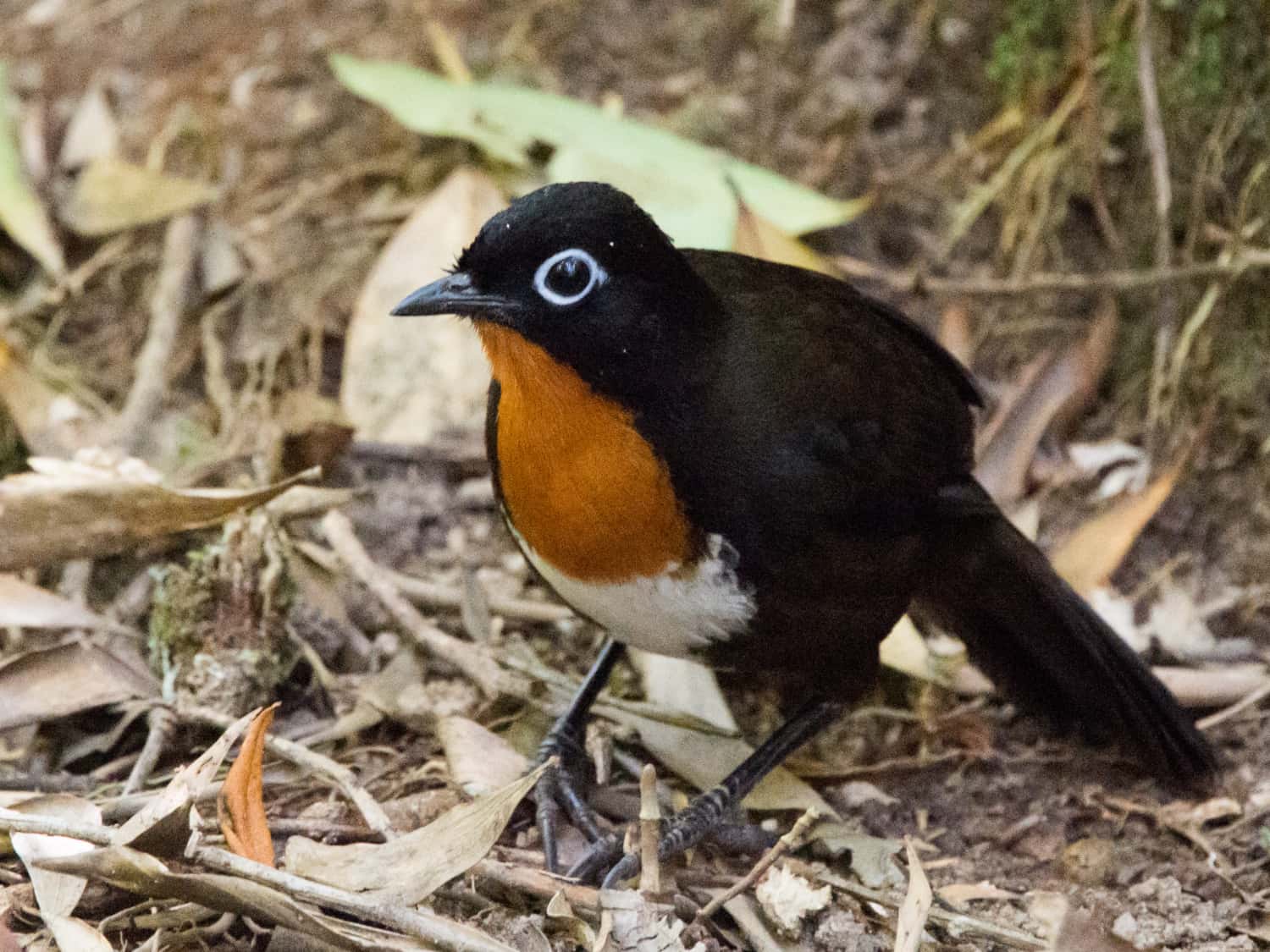
© Cassowary Tours
8. Chowchilla Orthonyx spaldingii
Wet Tropic endemic. Uncommon. Rainforest. Mid to high altitude. Year-round. Ground-dwelling, raucous bird that forages noisily in leaf debris on the rainforest floor. Often forages in pairs or family groups of half a dozen or more. Legs kick leaf litter sideways, leaving quite distinctive circular scratchings. Smaller birds, particularly Fernwren, may follow foraging parties to take insects revealed in the more vigorous diggings of Chowchillas. Loud raucous stream of calls including mimicry. Best Sites: Mt Lewis, Black Mountain Rd, Mt Hypipamee NP, Wongabel SF, Crater Lakes NP. Accommodations: Cassowary House, Crater Lakes Rainforest Cottages.
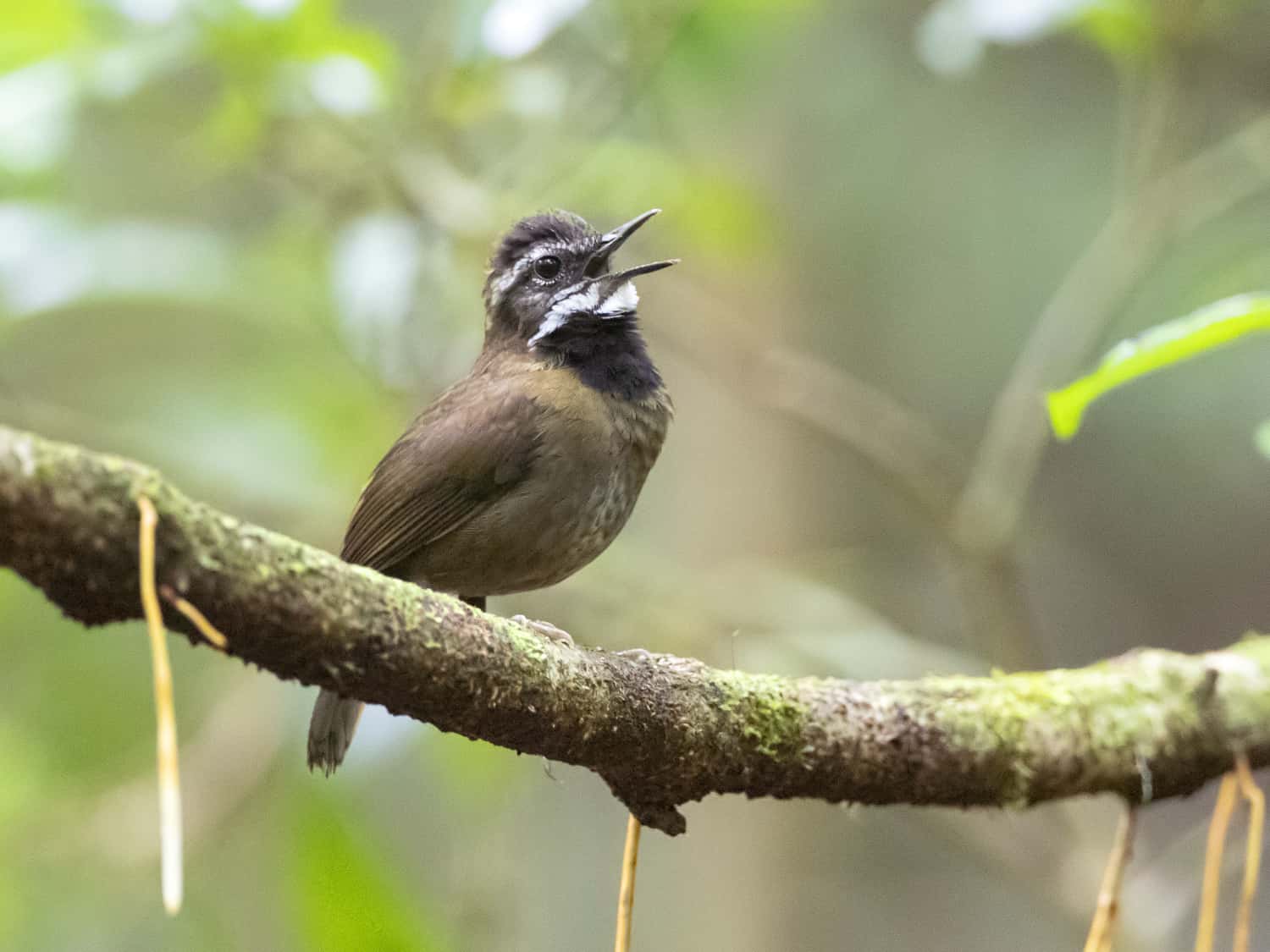
© Dean Ingwersen
9. Fernwren Oreoscopus gutturalis
Wet Tropic endemic. Uncommon. Rainforest. Mid to high altitude. Year-round. Delightful, small mouse-like bird of the rainforest floor, forages through deep leaf litter, sometimes disappearing briefly under logs, between rocks. Usually solo or in pairs. Sometimes follows Chowchillas, finding insects in diggings. Call is a penetrating series of drawn-out notes, seemingly ascending and getting louder. Best Sites: Mt Lewis, Mt Hypipamee, Crater Lakes NP. Accommodations: No accommodations have this bird regularly on site.
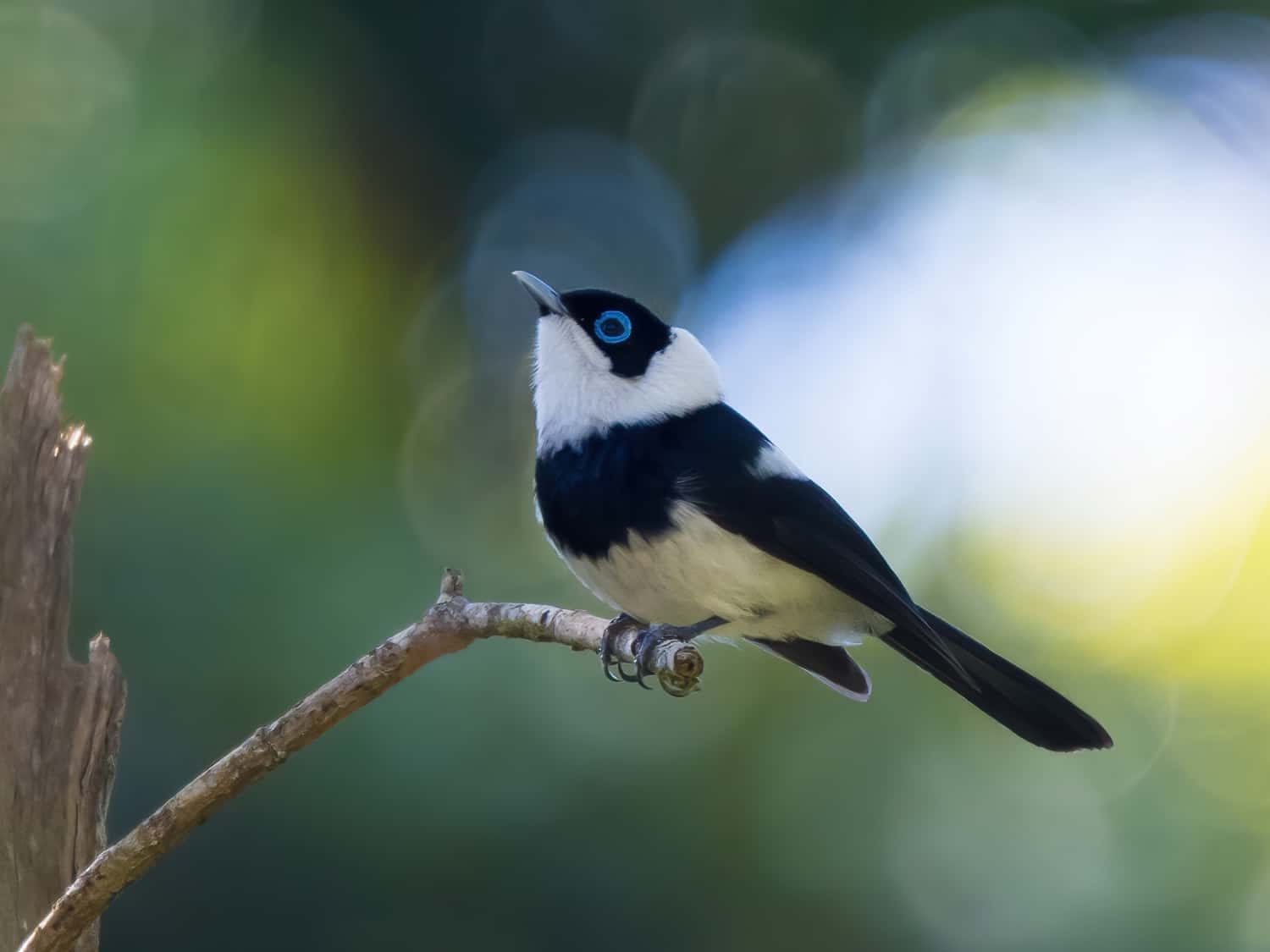
© Cassowary Tours
10. Pied Monarch Arses kaupi
Wet Tropic endemic. Fairly common. Rainforest & woodlands. All altitudes. Year-round. Delightful black and white monarch with a blue eye ring that often forages on tree trunks and branches, sometimes upside down, searching for small insects. Usually in pairs, usually in mid canopy. Call is a rapid repetitive series of the same note, like an alarm. Best Sites: Mossman Gorge, Stewart Creek Rd, Black Mountain Rd, Curtain Fig NP, Mt Hypipamee NP, Wongabel SF, Crater Lakes NP. Accommodations: Atherton Tablelands Birdwatchers’ Cabin, Cassowary House, Crater Lakes Rainforest Cottages.
Birds No. 11 – 20
Papuan Frogmouth, Spotted Whistling-duck, Red-rumped Swallow, Sarus Crane, Rufous Owl, Great-billed Heron, Little Kingfisher, Spotted Catbird, Grey-headed Robin, Atherton Scrubwren.
Descriptions, Best Sites, Accommodations
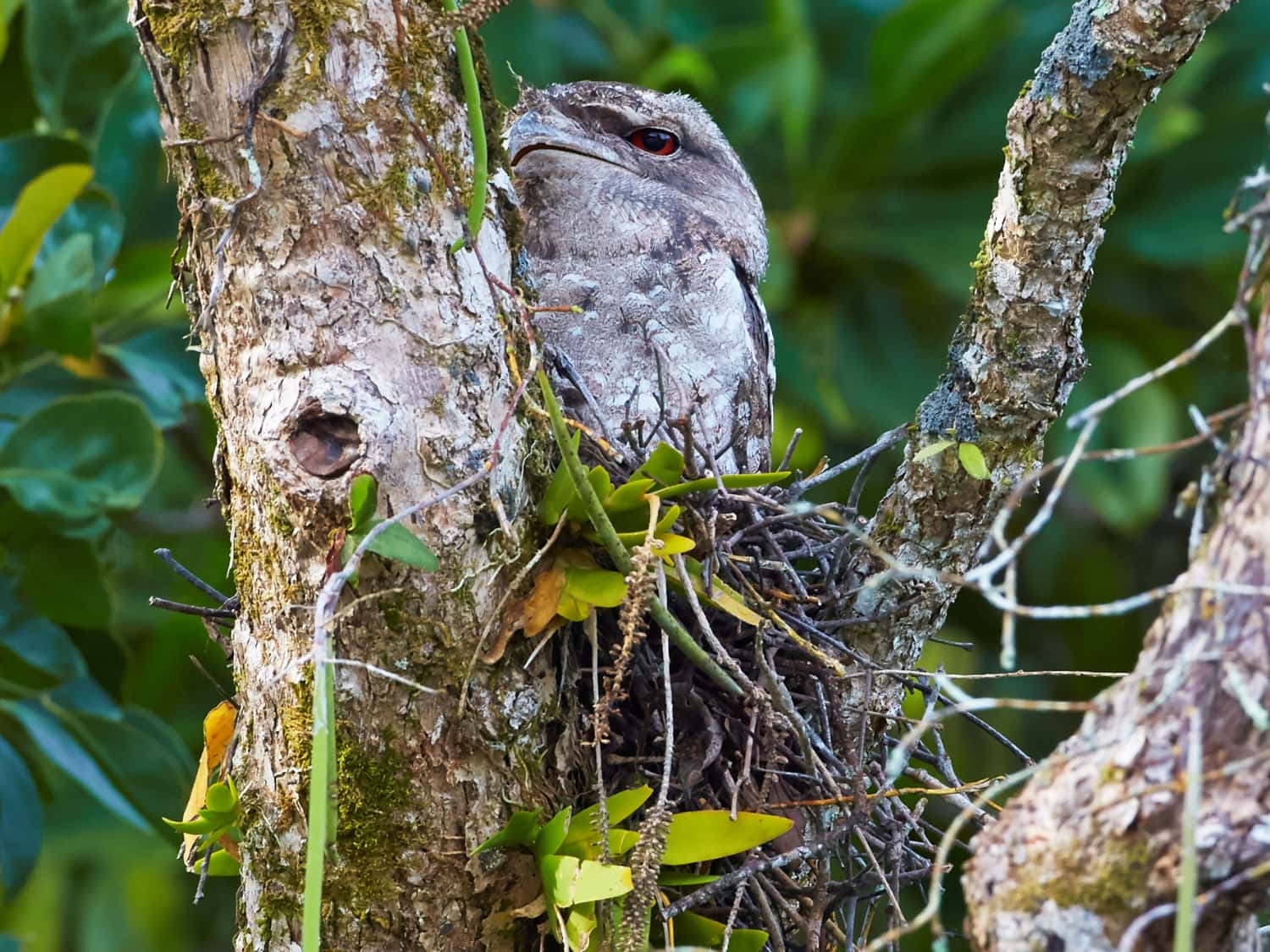
© Martin Willis, Daintree Boatman Cruises
11. Papuan Frogmouth Podargus papuensis
Resident. Difficult to find. Mostly wetter forests and creeklines. All altitudes. Year-round. Nocturnal hunter of insects, bugs, frogs. Hides during the day, sitting motionless, often in regular roosting sites, using extreme camouflage to look like part of the tree or vegetation. Larger, more blotched relative of the Tawny Frogmouth. May be found sitting on fenceposts or signposts along roads after dark particularly in rural areas. Often has favourite nesting sites. Nest is a loose assortment of sticks generally about 5 to 10m above the ground. Best Sites: Centenary Lakes, Flecker Botanical Gardens, Daintree Village (a specialty of Daintree River cruises). Accommodations: Thala Beach Nature Reserve.
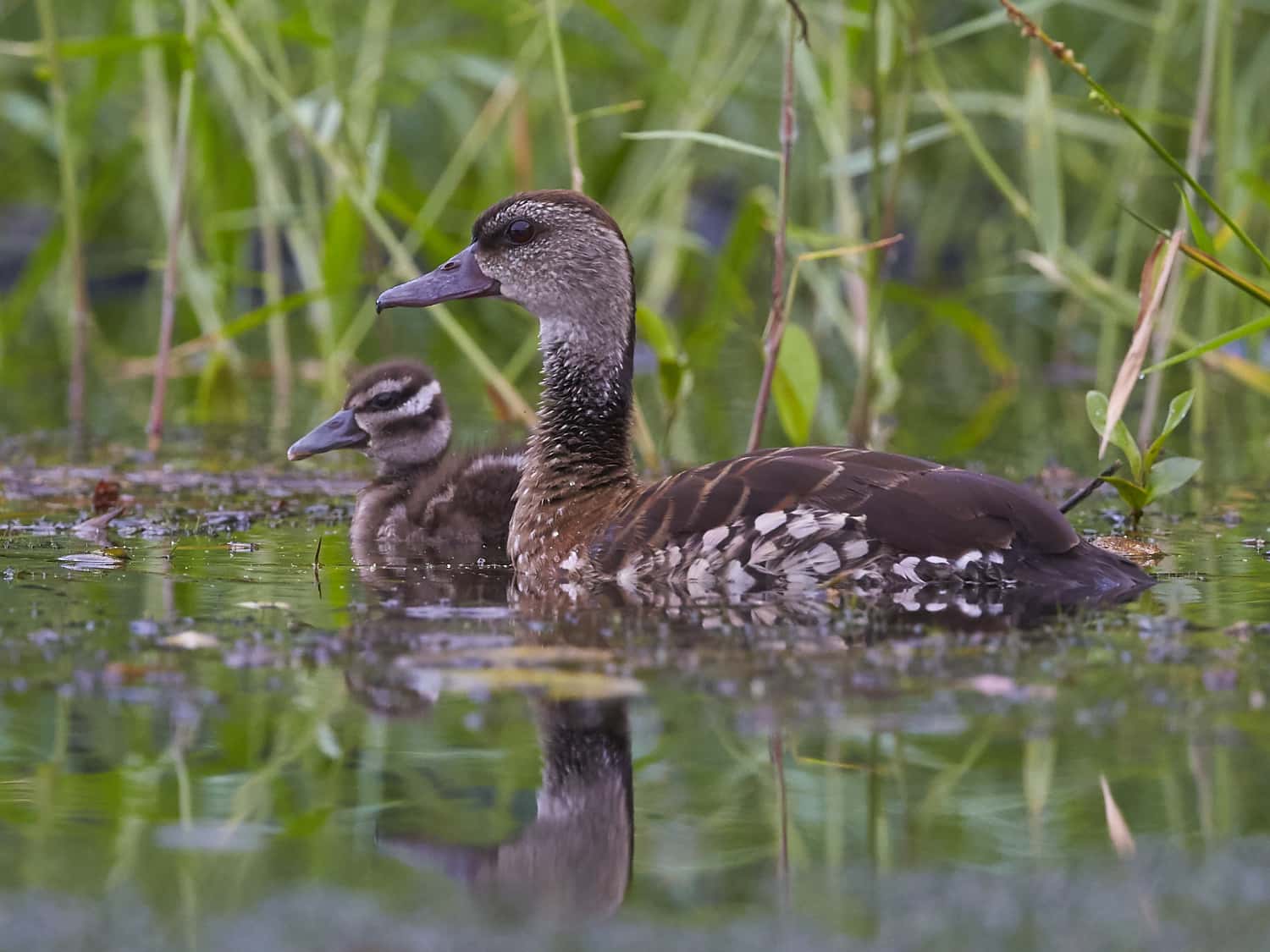
© Martin Willis, Daintree Boatman Cruises
12. Spotted Whistling-duck Dendrocygna guttata
Seasonal migrant, possibly a resident. Uncommon. Wetlands. Easier in spring and summer. Originally from Papua New Guinea, these ducks have colonised North Queensland over the past decade and are becoming increasingly common. They are most likely to be present and visible during Spring and Summer but increasingly they are being seen throughout the year. Over the last few years they have started to breed in Australia, usually about May. They are generally associated with ponds that contain waterlilies. Best Sites: Centenary Lakes, Cattana Wetlands, Daintree Village (a specialty of Daintree River cruises). Accommodations: No accommodations have this bird regularly on site.
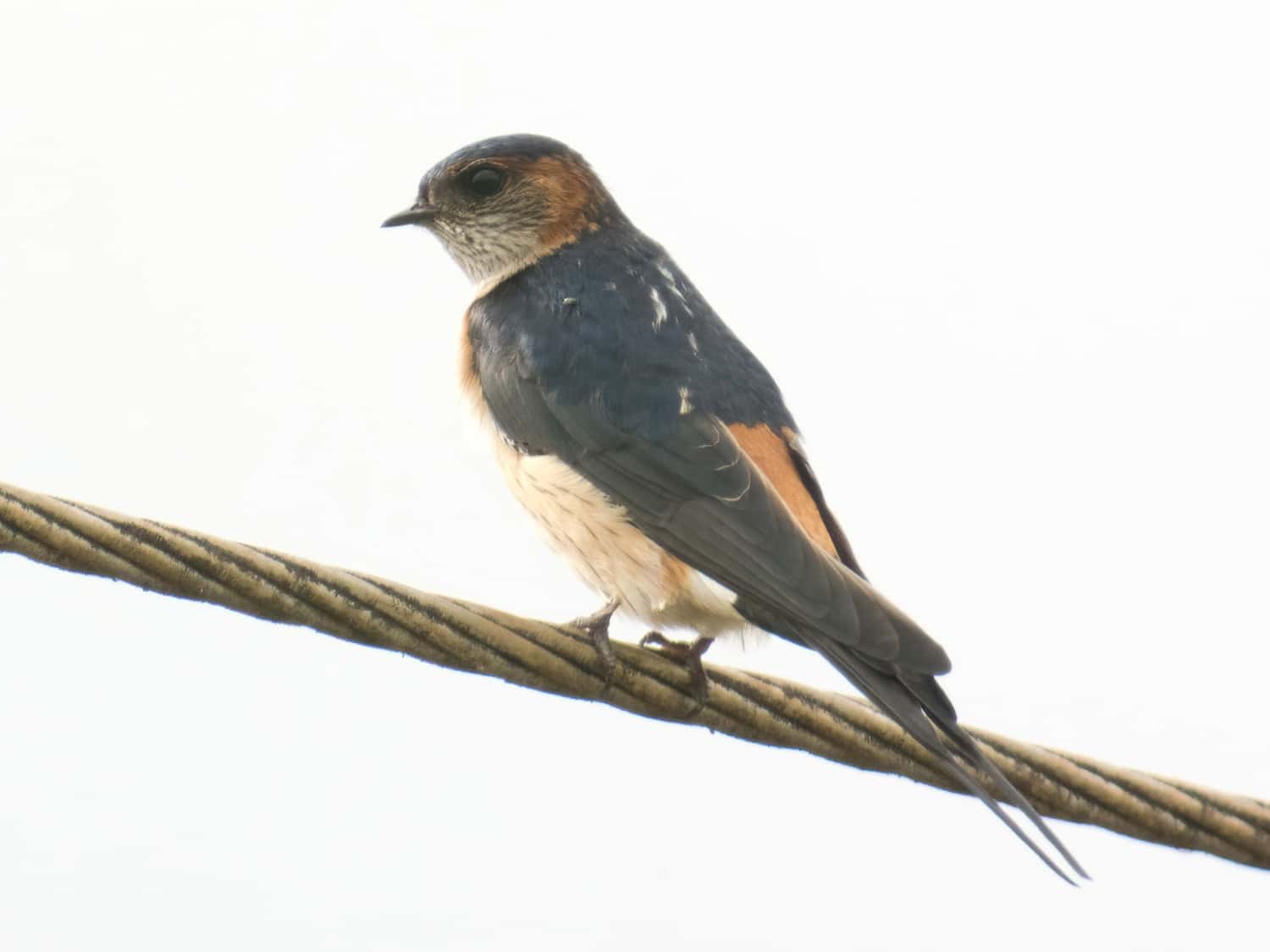
© Cassowary Tours
13. Red-rumped Swallow Cecropsis daurica
Regular summer vagrant. Sits on powerlines. All altitudes. Summer. Most summers these swallows will arrive in small numbers, sometimes after the first cyclone of the season. Historically a common spot was near the water tower in the settlement of Newell Beach. More recently they have been recorded annually near the Avenue of Honour in Yungaburra. Best Sites: No specific brochure sites. Accommodations: No accommodations have this bird regularly on site.
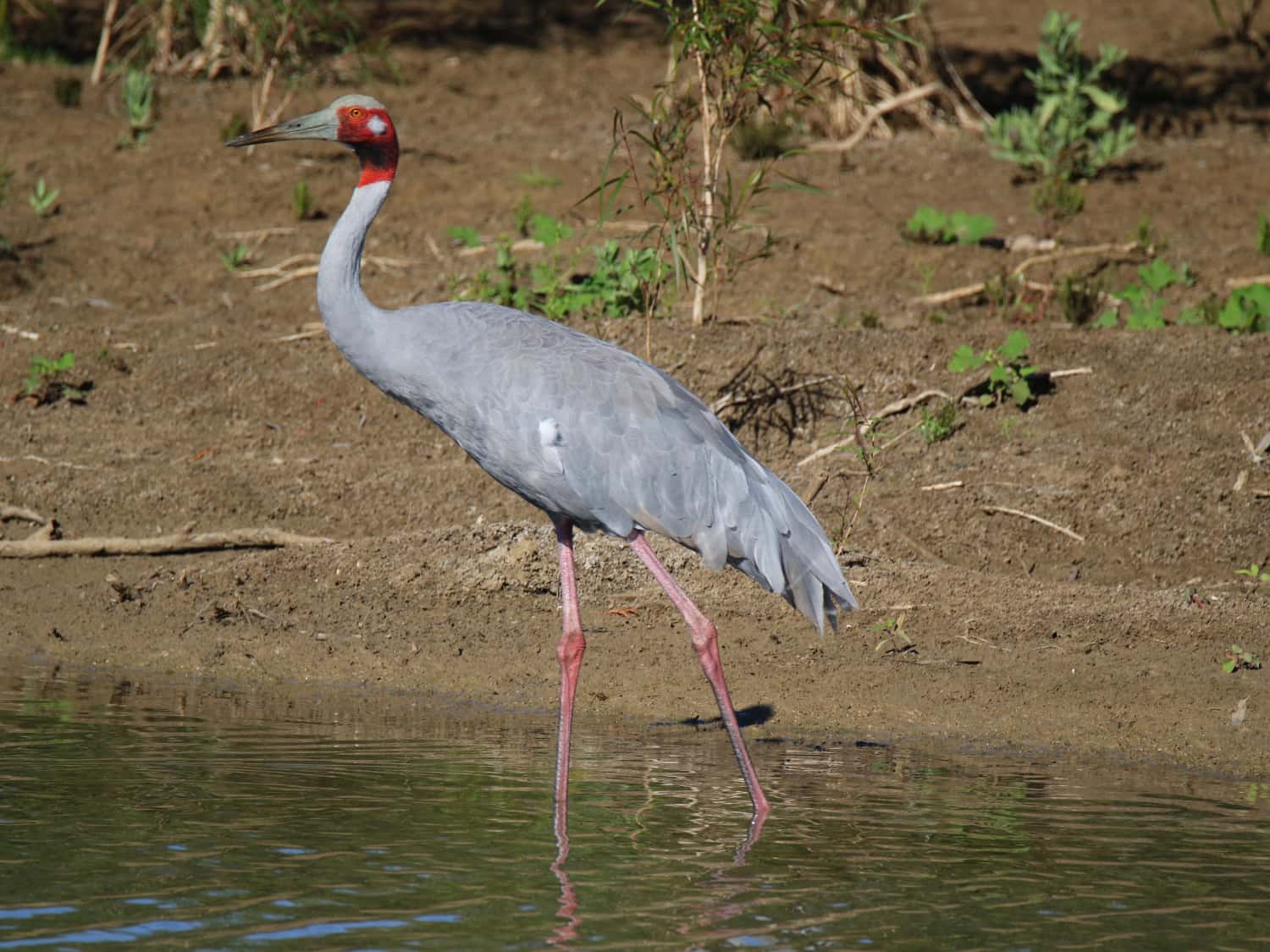
© Birdwatching Tropical Australia
14. Sarus Crane Grus antigone
Seasonal migrant. Wetlands and fields. Mostly mid to high altitude. Winter & spring. Largest crane in the world. Present in the Wet Tropics, particularly the agricultural fields on the Atherton Tableland, from June to October. Often seen in mixed groups with Brolga foraging in fields or coming to roost at wetlands, particularly Bromfield Swamp. Disperses about October to breed in Gulf Country. Best Sites: Lake Mitchell, Tinaroo Creek Road, Pelican Point, Hasties Swamp, Bromfield Swamp. Accommodations: No accommodations have this bird regularly on site.
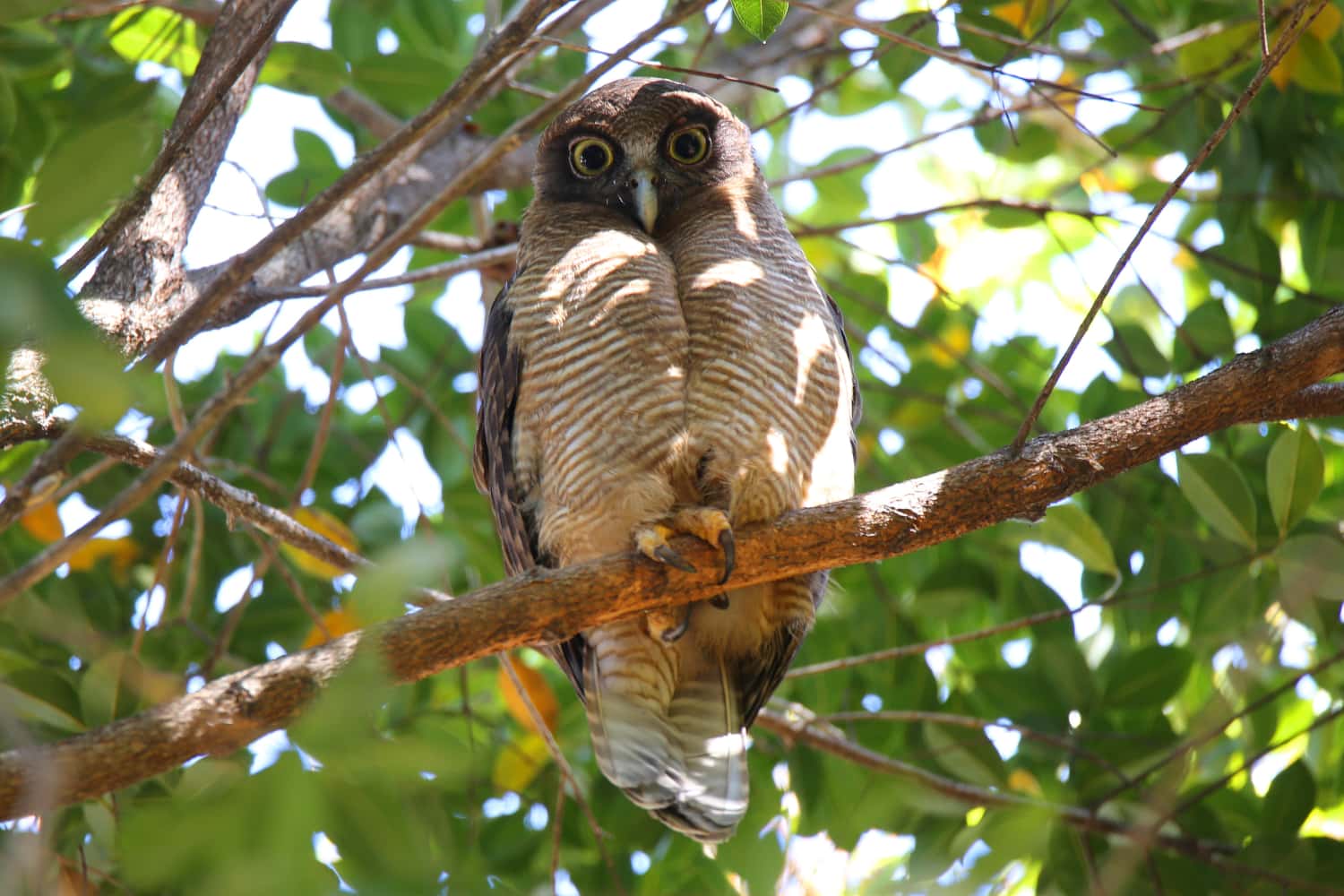
© Birdwatching Tropical Australia
15. Rufous Owl Ninox rufa
Resident. Uncommon. Rainforest & woodland. Mostly lowland. Year-round. Very large reddish-coloured owl. In recent years there have been some regular roosts in Cairns including Les Davies Park. Usually nesting in spring when may be most observable. Will often use a large fig or other large rainforest trees as a shady roosting site by day, either solo or in pairs. Best Sites: Emerald Creek. Accommodations: Thala Beach Nature Reserve.
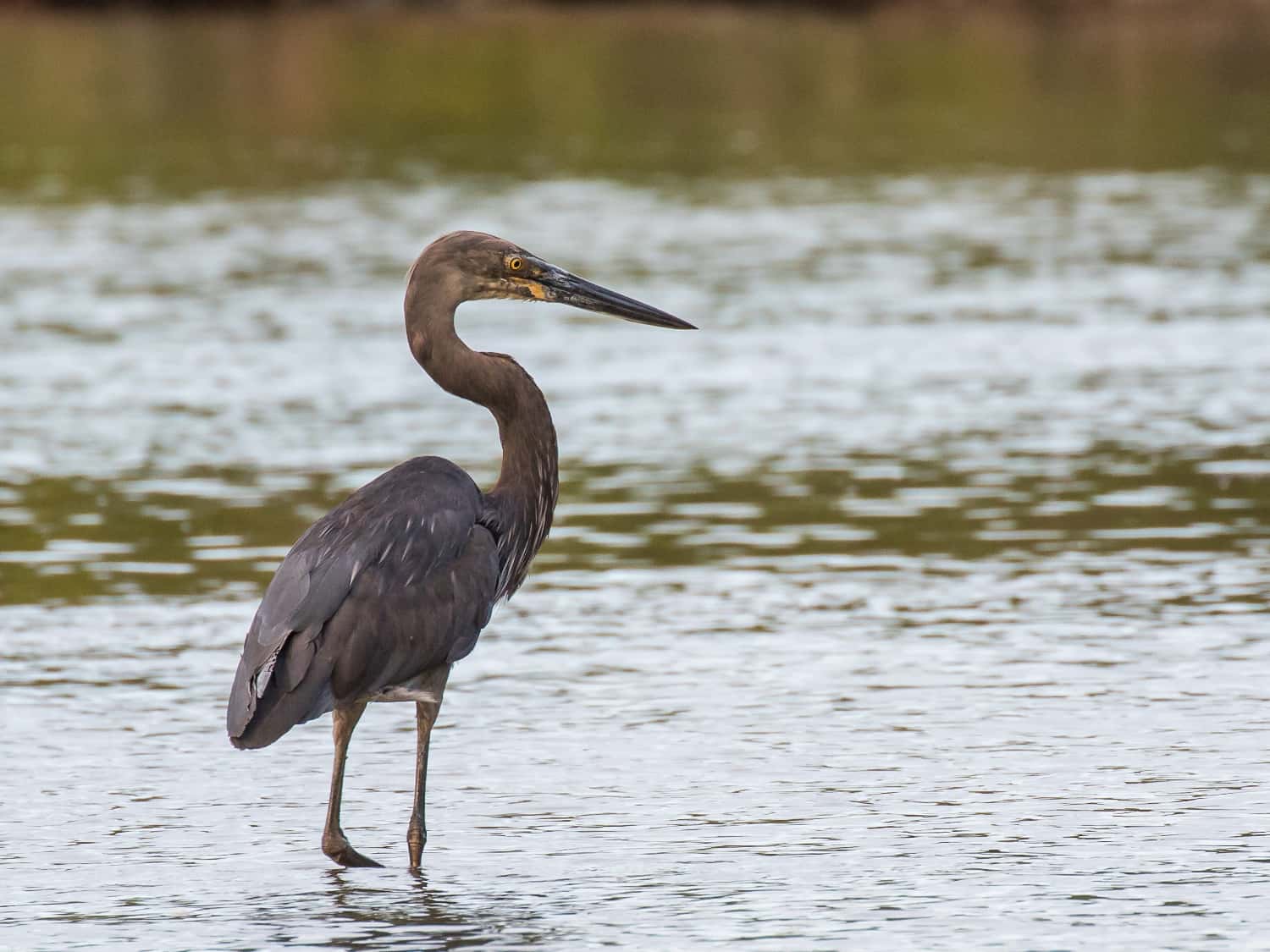
© Alfred Schulte, Daintree Boatman Cruises
16. Great-billed Heron Ardea sumatrana
Resident. Uncommon. Rivers & estuaries. Low to medium altitude. Year-round. A large slaty-grey heron, generally secretive, mostly residing in coastal creeks and rivers. Will occasionally be observed foraging on mud of low tide in estuaries. Best Sites: Cairns Foreshore, Redden Island, Newell Beach, Daintree Village (a specialty of Daintree River cruises). Accommodations: No accommodations have this bird regularly on site.
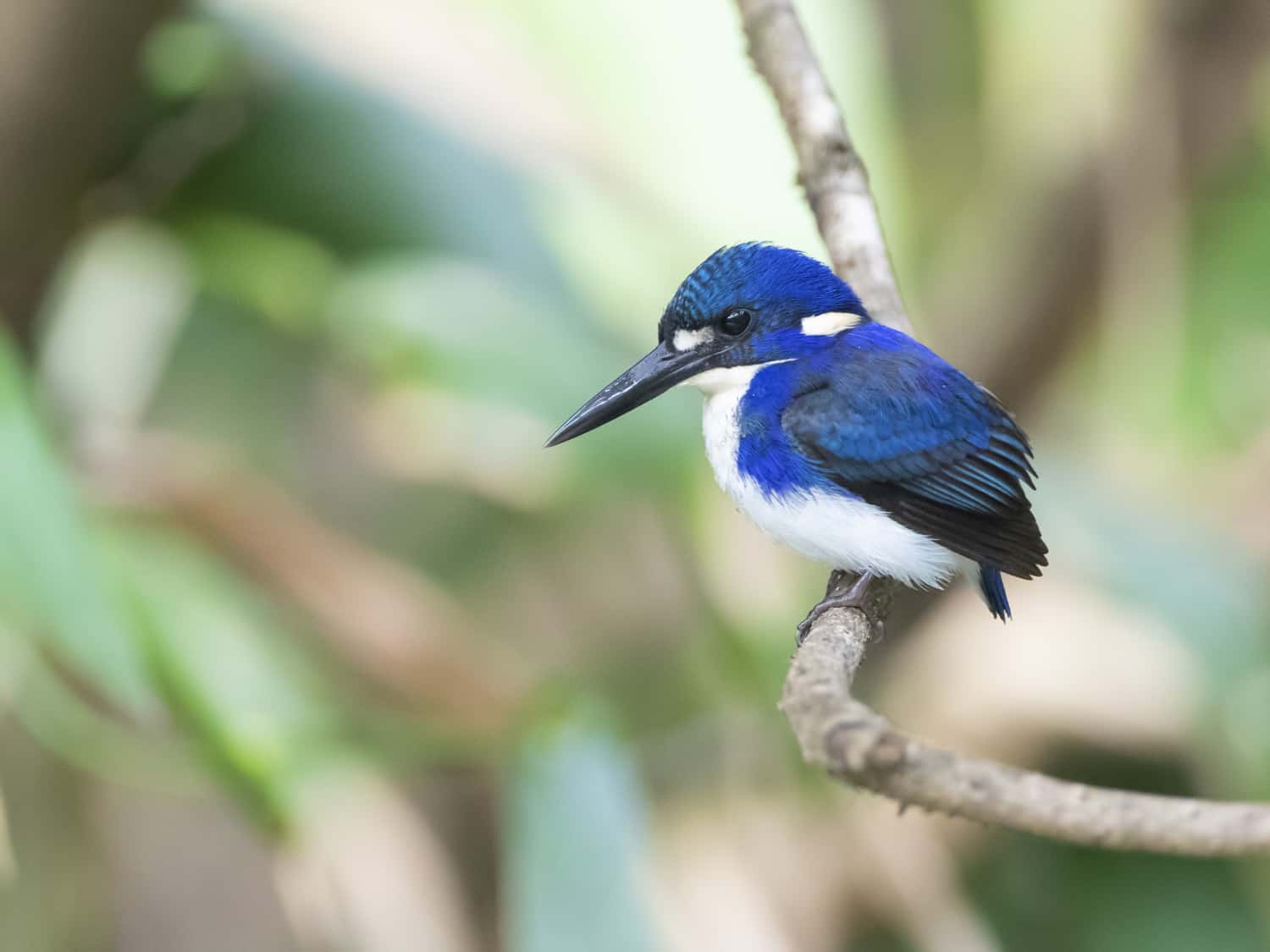
© Dean Ingwersen, Daintree Boatman Cruises
17. Little Kingfisher Ceyx pusilla
Resident. Uncommon. Rivers & wetlands. Low to mid altitude. Easier in winter. A tiny blue and white kingfisher roughly half the size of the Azure Kingfisher. Generally recorded as the second smallest kingfisher of the world. Possibly an altitudinal migrant, moving to higher elevations during the warmth of summer. Best conditions for observance on a Daintree cruise is a low-tide in cooler months. Best Sites: Centenary Lakes, Hasties Swamp, Daintree Village (a specialty of Daintree River cruises). Accommodations: Thala Beach Nature Reserve.
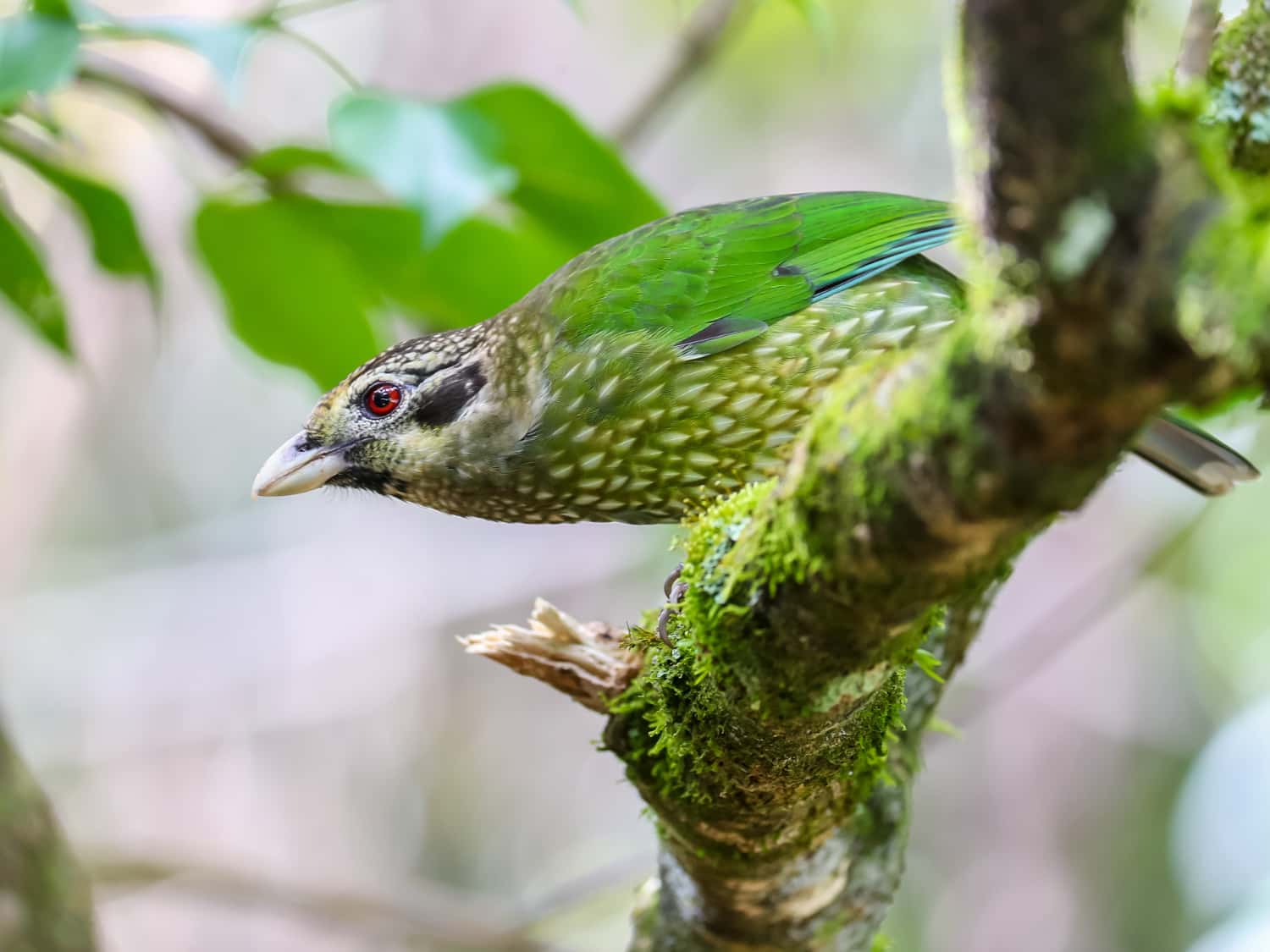
© Dom Chaplin
18. Spotted Catbird Ailuroedus melanotis
Wet Tropic endemic. Common. Rainforest. Mid to high altitude. Year-round. Recently separated from Black-eared Catbird (present in the Iron Range region) to become a ‘new’ Wet Tropics endemic species. Loud distinctive cat-like ‘mewing’ call. Often hidden in rainforest canopy, can be difficult to see well, but will attend feed stations at accommodations. Best Sites: Mt Lewis, Mt Hypipamee NP, Curtain Fig NP, Crater Lakes NP. Accommodations: Cassowary House, Crater Lakes Rainforest Cottages, Atherton Tablelands Birdwatchers’ Cabin.
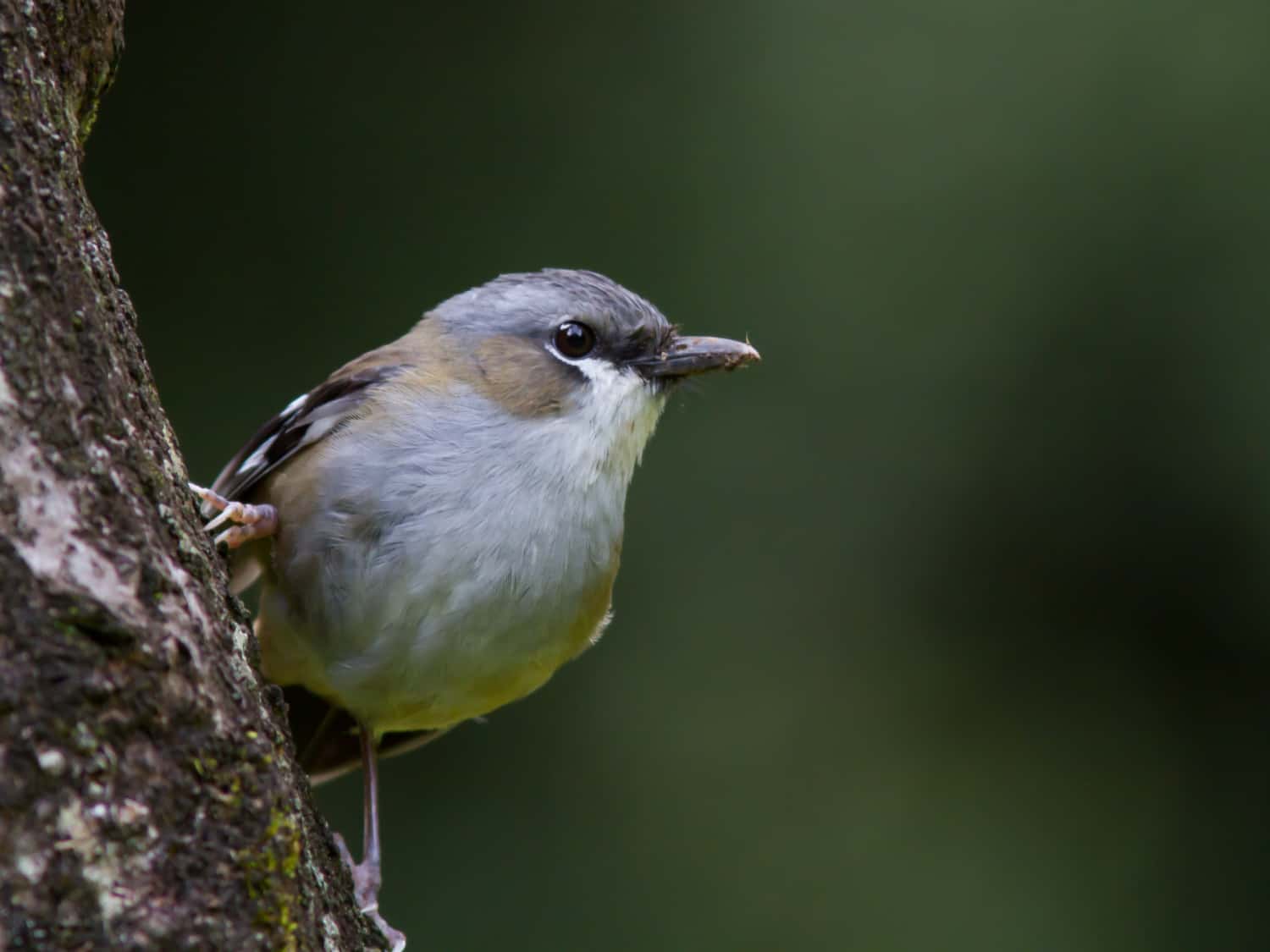
© Alfred Schulte
19. Grey-headed Robin Heteromyias cinereifrons
Wet Tropic endemic. Common. Rainforest. Mid to high altitude. Year-round. Likely to be encountered at rainforest picnic grounds, particularly Mt Hypipamee. Some movement to lower elevation possible in cooler months. Best Sites: Mt Lewis, Mt Hypipamee NP, Curtain Fig NP, Crater Lakes NP. Accommodations: Atherton Tablelands Birdwatchers’ Cabin, Crater Lakes Rainforest Cottages, Sweetwater Lodge.
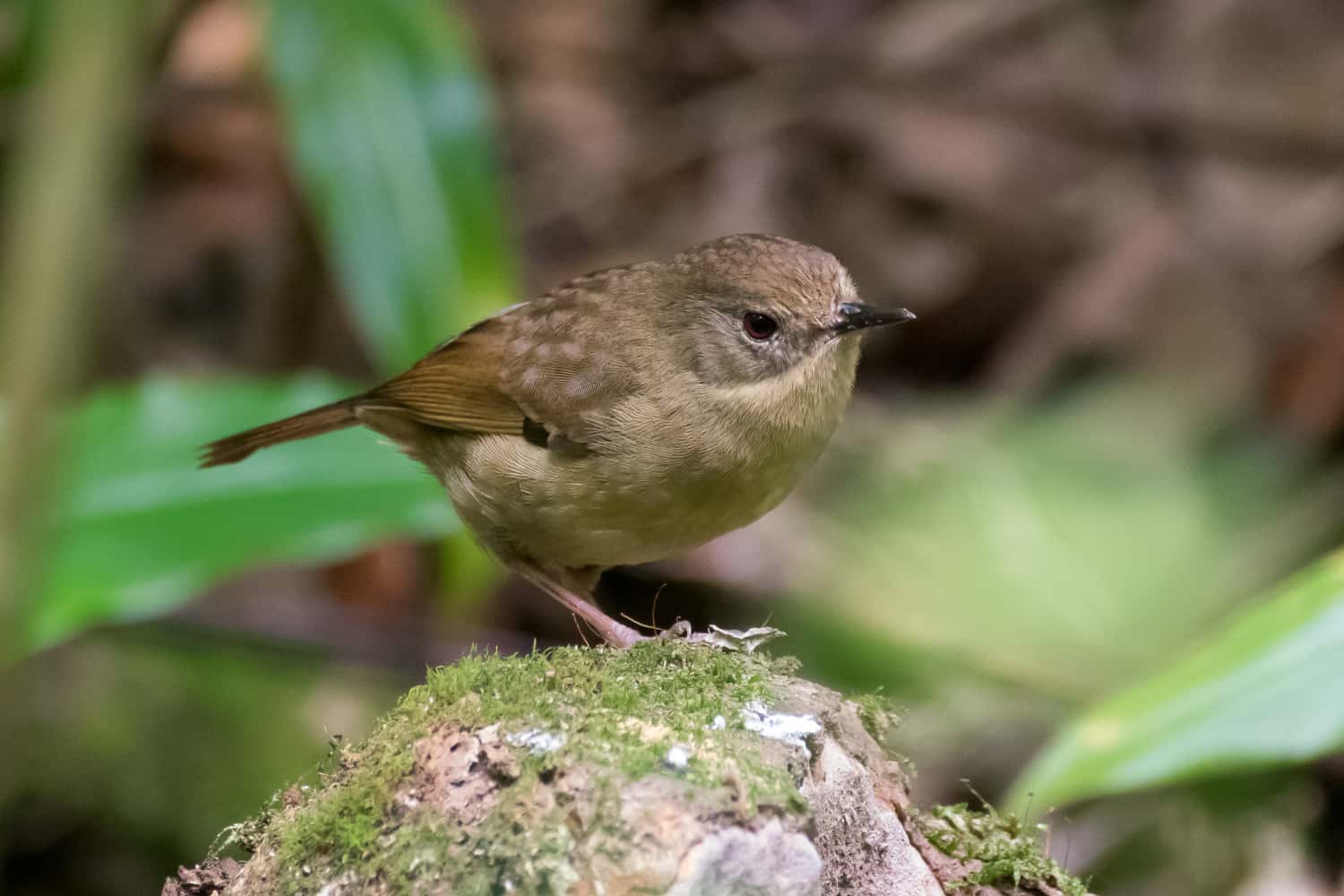
© Cassowary Tours
20. Atherton Scrubwren Sericornis keri
Wet Tropic endemic. Uncommon. Rainforest. Mid to high altitude. Year-round. Small brownish scrubwren generally on the rainforest floor. Generally above 400m. Can forage in understory a few metres off the ground. Usually solo or in pairs. Care need to be taken to differentiate from the Large-billed Scrubwren. In general, the Atherton Scrubwren is more sedentary, more usually solo or pairs rather than groups, has larger feet and is more uniformly darker in colour. Best Sites: Mt Lewis, Mt Hypipamee NP. Accommodations: Atherton Tablelands Birdwatchers’ Cabin, Crater Lakes Rainforest Cottages.
Birds No. 21 – 30
Bower’s Shrike-thrush, Cryptic Honeyeater, Macleay’s Honeyeater, Bridled Honeyeater, Mountain Thornbill, Beach Stone-curlew, Lovely Fairy-wren, Black Bittern, Mangrove Robin, Torresian Kingfisher.
Descriptions, Best Sites, Accommodations
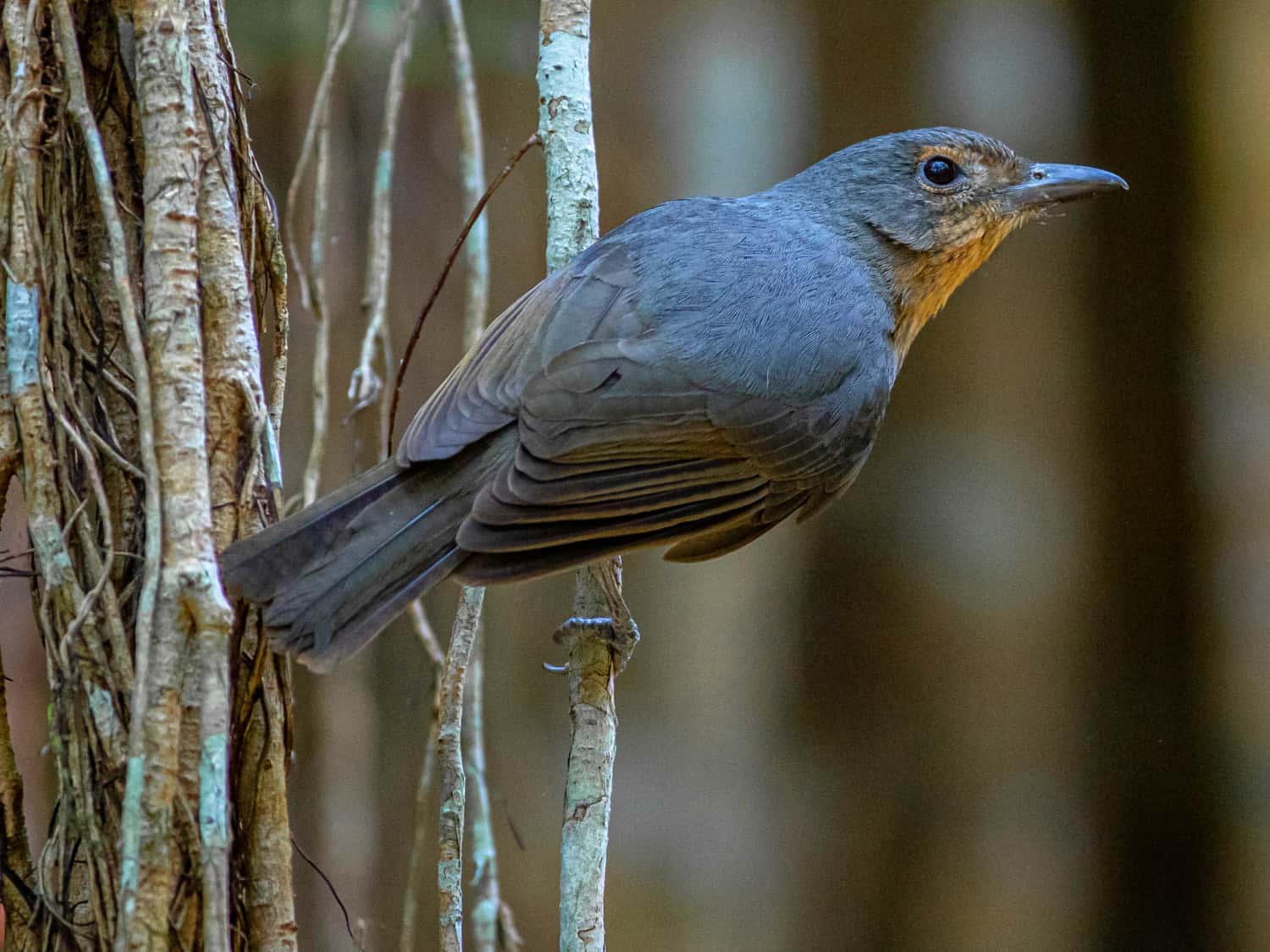
© Dom Chaplin
21. Bower’s Shrike-thrush Colluricincla boweri
Wet Tropic endemic. Uncommon. Rainforest. Mid to high altitude. Year-round. Large shrike-thrush, with orange-rufous underparts, with large black bill much larger than its smaller relative Rufous Shrike-thrush. Distinctive call. They are more common at mid to high altitude, above 400m, but in cooler months some move to coastal lowlands. Best Sites: Mt Lewis, Mt Hypipamee NP, Curtain Fig NP, Crater Lakes NP. Accommodations: Atherton Tablelands Birdwatchers’ Cabin, Crater Lakes Rainforest Cottages.
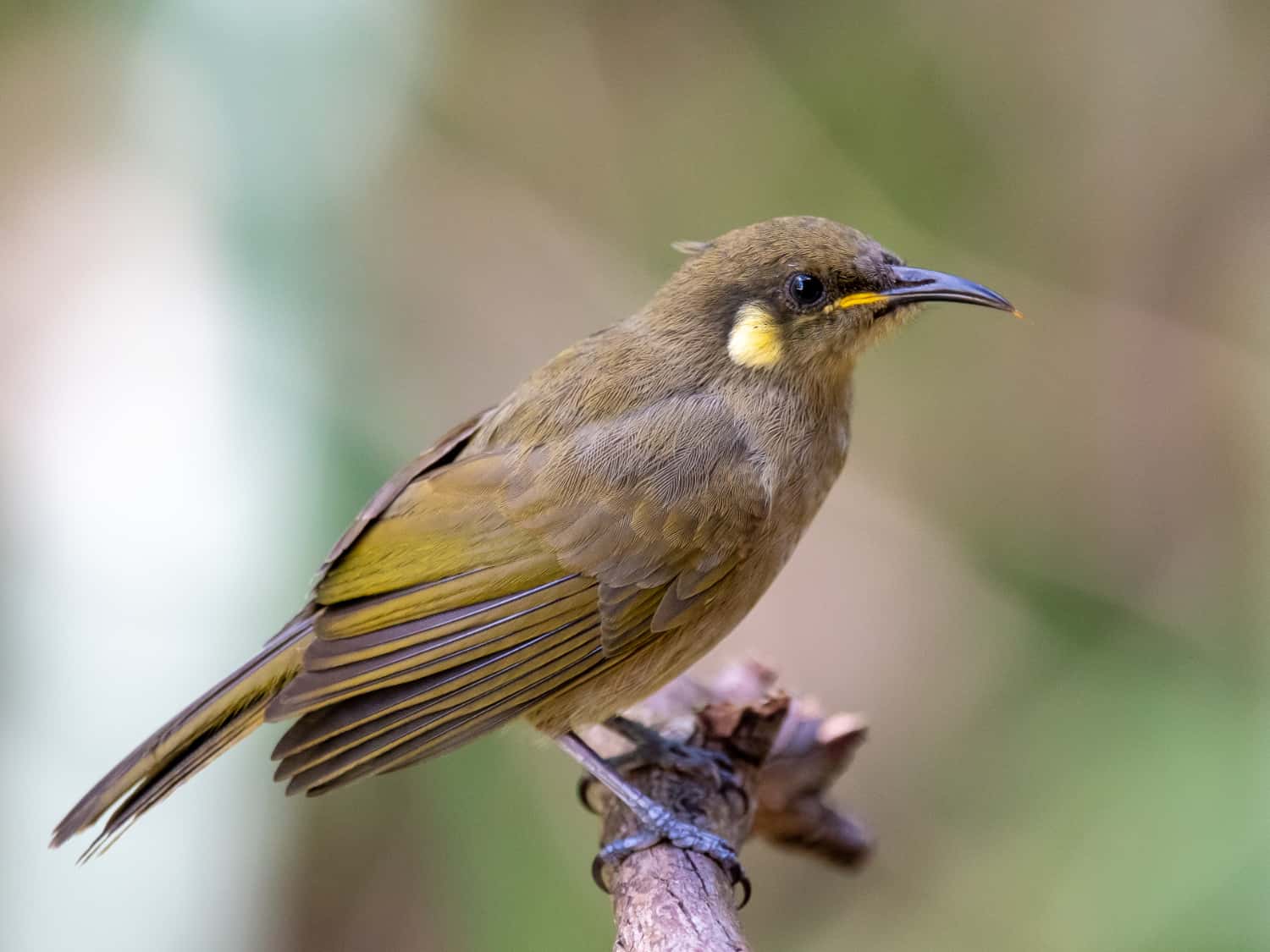
© Cassowary Tours
22. Cryptic Honeyeater Microptilotis imitatrix
WT ‘near’ endemic. Common. Rainforest, woodlands, parklands. Low to mid altitudes. Year-round. Recently separated from Graceful Honeyeater (Cape York region) to become a ‘new’ Wet Tropics ‘near’ endemic species. This honeyeater should be found at most sites, foraging on flowering plants and visiting birdbaths. Care needs to be taken to separate this common species from the slightly larger, very similarly coloured Yellow-spotted Honeyeater. Best Sites: Should be found at most sites. Accommodations: Should be found at most accommodations.
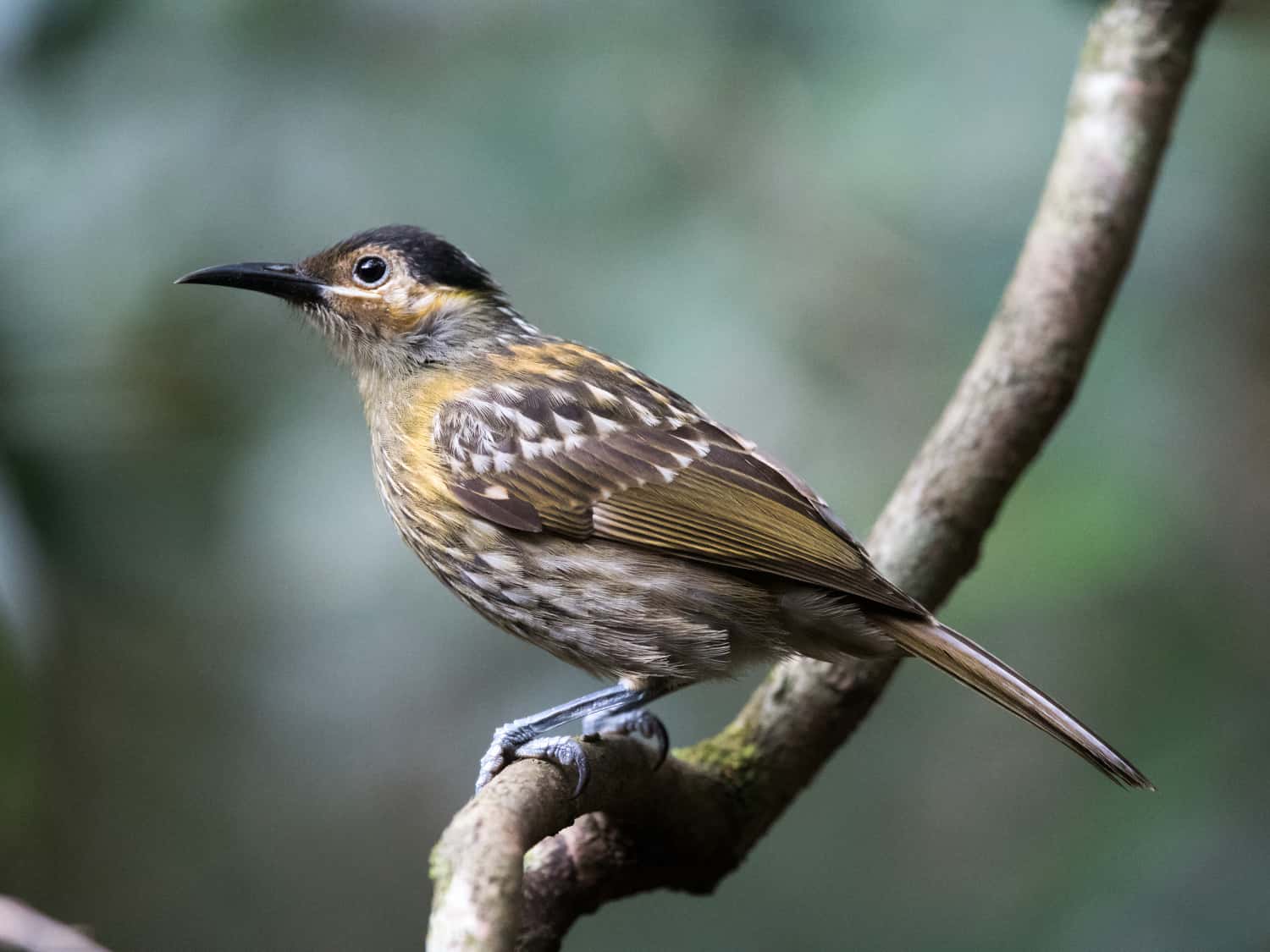
© Cassowary Tours
23. Macleay’s Honeyeater Xanthotis macleayanus
Wet Tropic endemic. Common. Rainforest, woodlands, gardens. All altitudes. Year-round. Common medium-sized grey-brown honeyeater with extensive streaking. Very often observed foraging on flowering shrubs in gardens or using either a feed table or water bath. Best Sites: Abattoir Swamp, Mt Molloy, (base of) Mt Lewis, Crater Lakes NP. Accommodations: Atherton Tablelands Birdwatchers’ Cabin, Crater Lakes Rainforest Cottages, Sweetwater Lodge, Thala Beach Nature Reserve, Villa Marine Holiday Apartments.
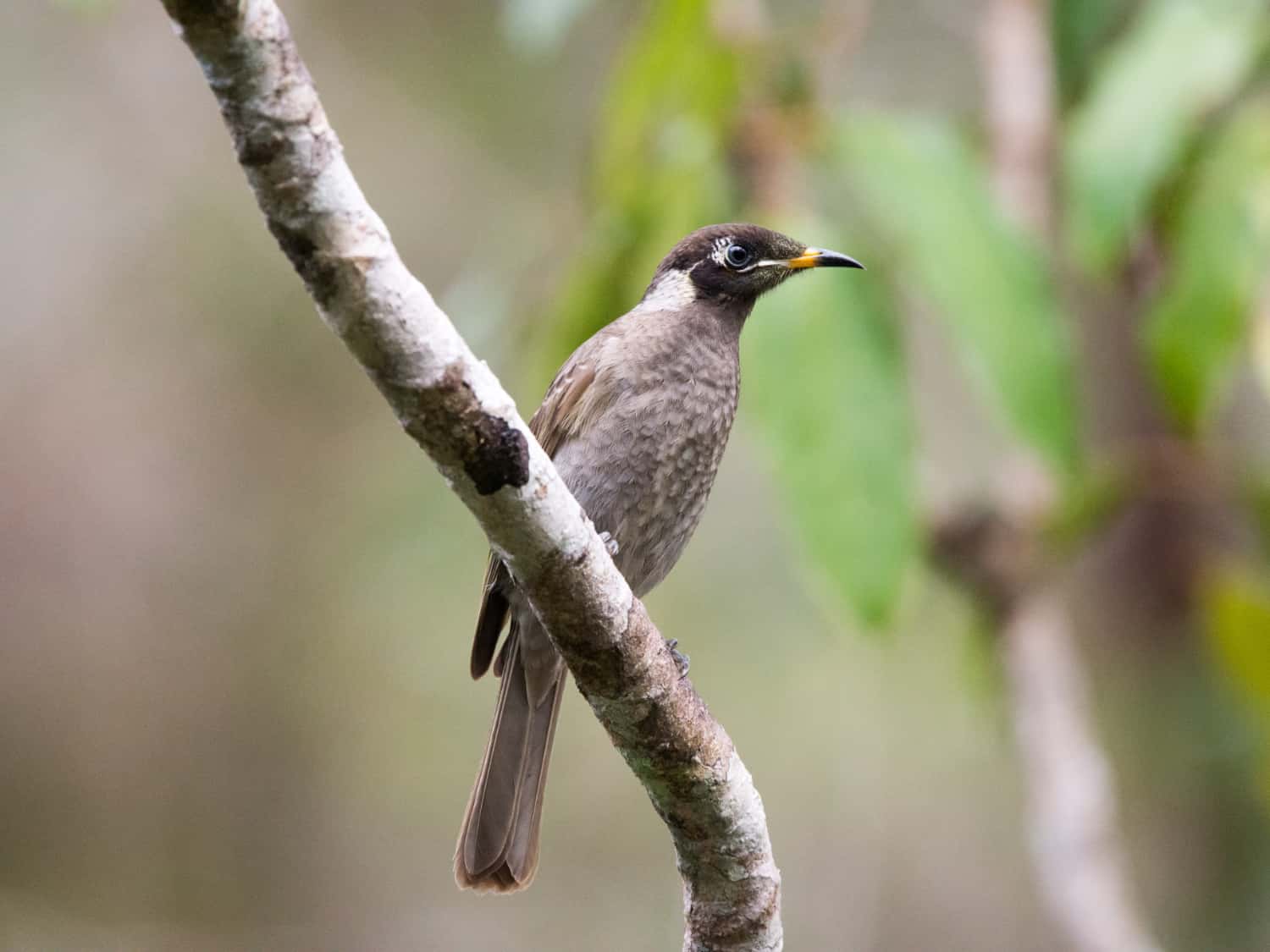
© Cassowary Tours
24. Bridled Honeyeater Lichenostomus frenatus
Wet Tropic endemic. Fairly common. Rainforest, woodlands, parklands. All altitudes. Year-round. Reasonably large honeyeater with distinctive yellowish horizontal line on dark face. Often in small flocks, pugnacious and vocal, feeding on red-flowering vegetation particularly Umbrella Tree. They are more common at mid to high altitude but in cooler months some move to coastal lowlands. Best Sites: Mt Lewis, Mt Hypipamee, Crater Lakes NP, Emerald Creek (winter). Accommodations: Atherton Tablelands Birdwatchers’ Cabin, Crater Lakes Rainforest Cottages, Sweetwater Lodge.
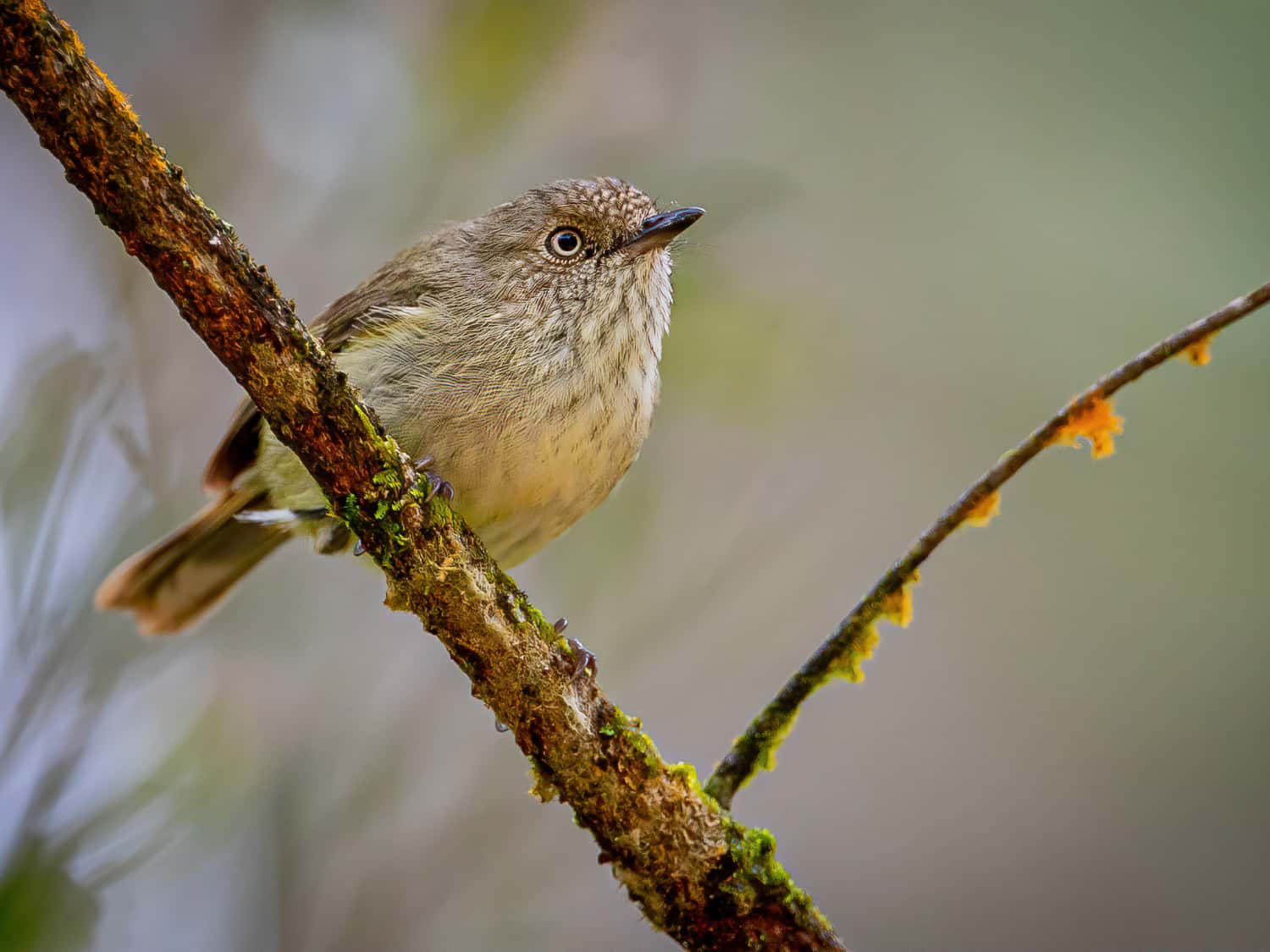
© Dom Chaplin
25. Mountain Thornbill Acanthiza katherina
Wet Tropic endemic. Common. Rainforest. Mid to high altitude. Year-round. Small pale thornbill with a pale eye and no white in the tail. Generally above 450m. Forages in pairs and small parties in foliage, often 3 to 5 metres above the ground. Sweet lovely call. Best Sites: Mt Lewis, Mt Hypipamee. Accommodations: Atherton Tablelands Birdwatchers’ Cabin, Sweetwater Lodge.
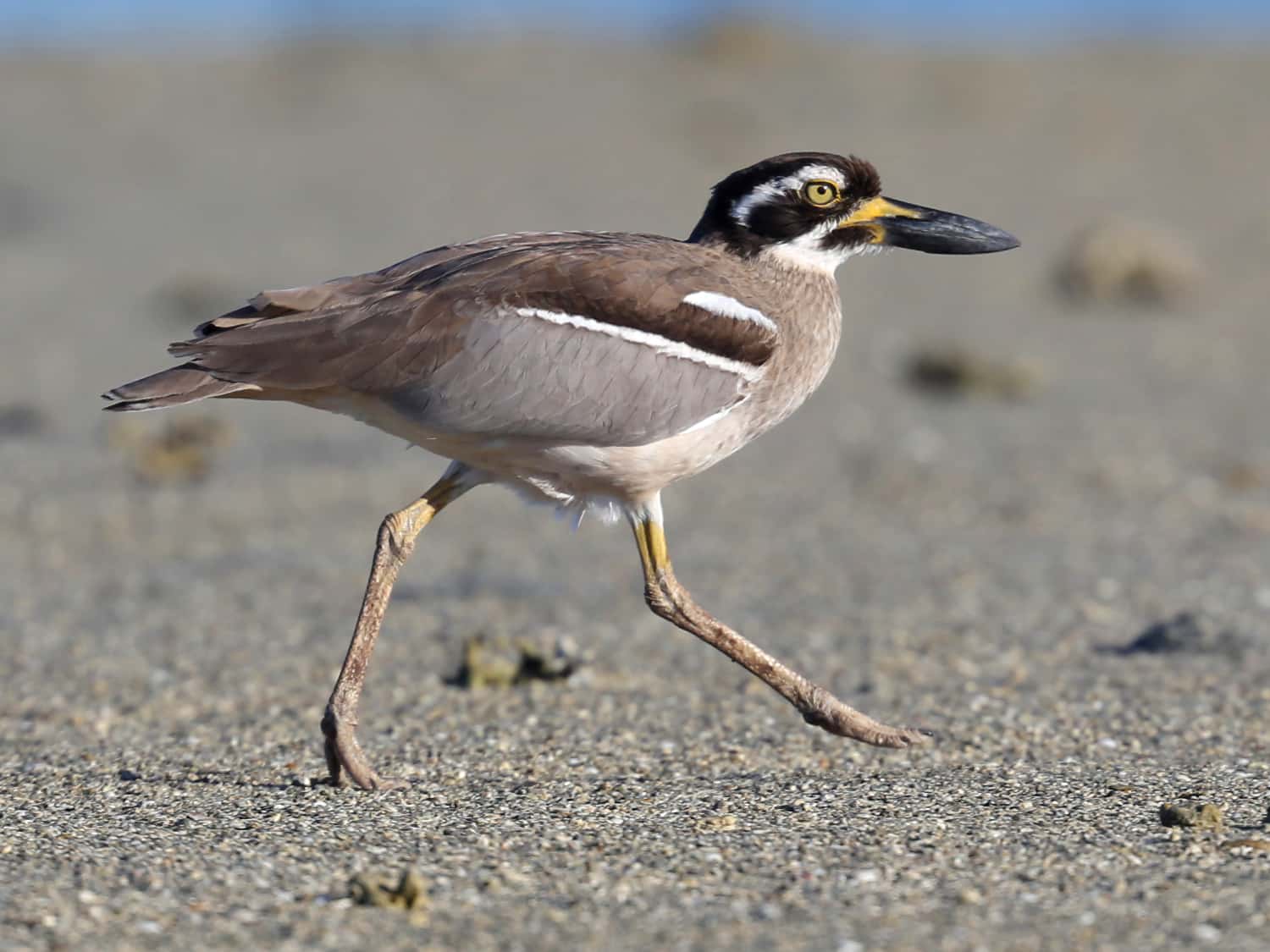
© Dom Chaplin
26. Beach Stone-curlew Esacus magnirostris
Resident. Uncommon. Beaches & estuaries. Low altitude. Year-round. Most beaches of the region will have a pair of Beach Stone-curlew. Large bill for catching crabs. Most likely to be found actively foraging as the tide recedes, and crabs emerge as mud becomes exposed. At higher tides they are likely to be more difficult, residing in debris or vegetation at and beyond the high tide line. Best on weekdays when beaches are less occupied by people and dogs. Best Sites: Cairns Foreshore, Redden Island, Yule Point, Newell Beach, Wonga Beach, Etty Bay. Accommodations: Thala Beach Nature Reserve.
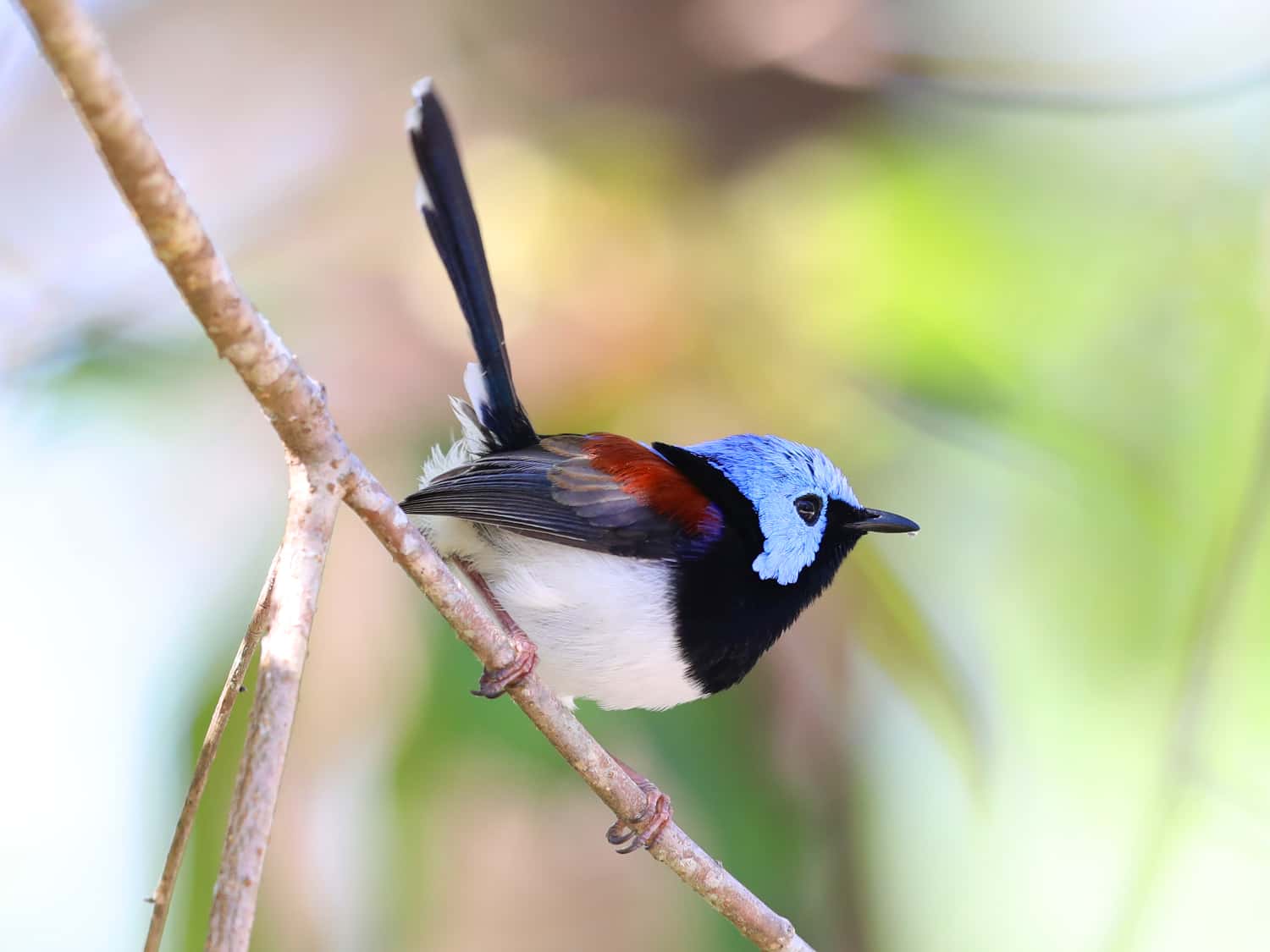
© Birdwatching Tropical Australia
27. Lovely Fairy-wren Malurus amabilis
Resident. Fairly common. Most habitats. Low to mid altitude. Year-round. Male wren is similar to the Variegated Wren, whilst the female is the most-coloured female wren with a blue head and saddle. Often forage arboreally in family parties of up to half a dozen. Habitat used is widespread including rainforest, paperbark forest, and mangroves. Best Sites: Centenary Lakes, Redden Island, Cattana Wetland, Stewart Creek Rd, (base of) Mt Lewis, Black Mountain Rd, Curtain Fig NP, Mt Hypipamee NP, Wongabel SF, Crater Lakes NP. Accommodations: Thala Beach Nature Reserve.
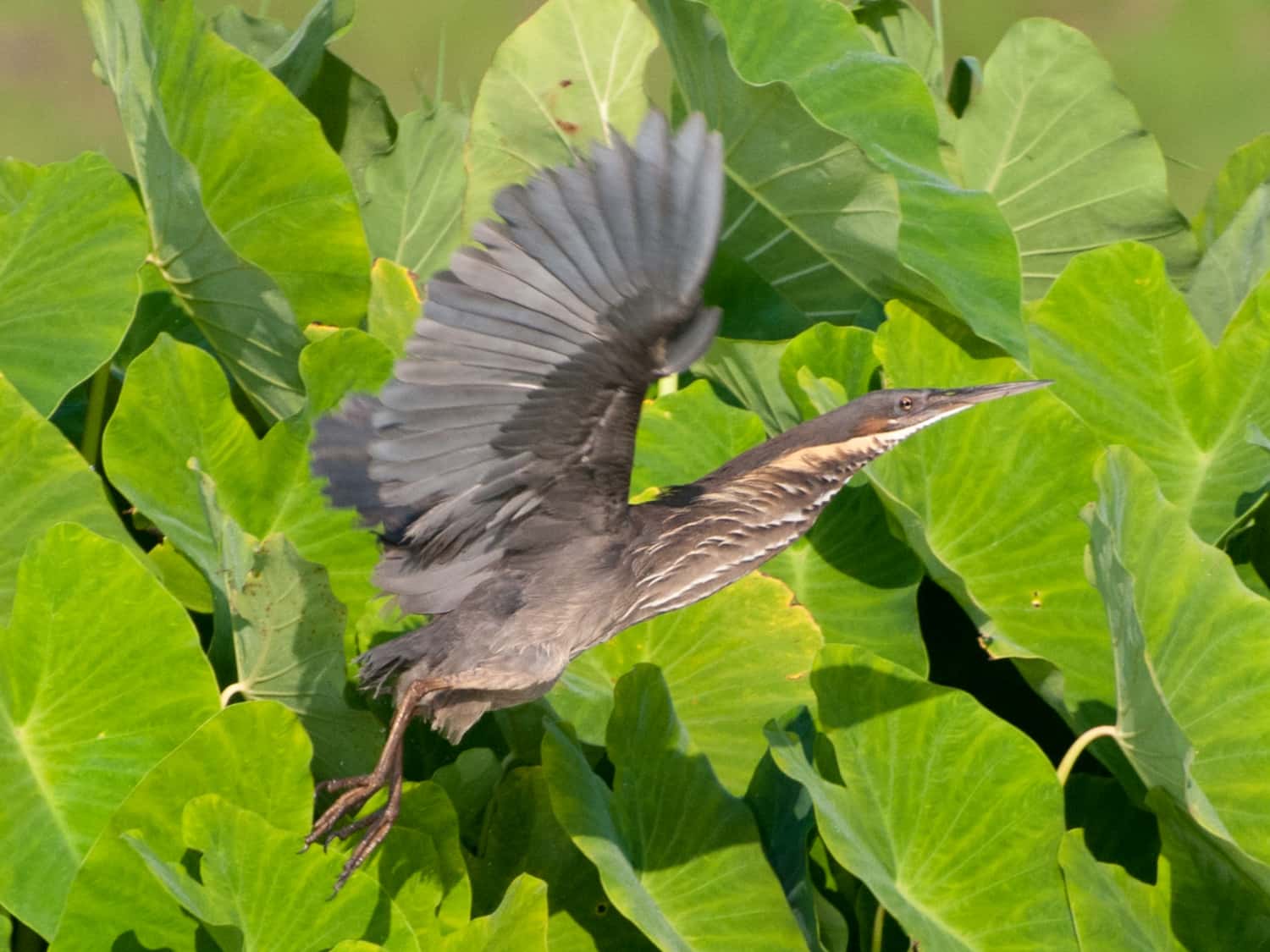
© Cassowary Tours
28. Black Bittern Ixobrychus flavicollis
Summer migrant. Uncommon. Rivers & wetlands. Low to mid altitude. October to April. A small dark grey heron, often with streaks on the chest. The male has straw-coloured facial stripes like a handlebar moustache. They are generally secretive, not often in the open. Present over the summer Wet Season period before migrating to Papua New Guinea and possibly the Gulf of Carpentaria. Often nests in Water Gums along the Daintree River from December to March. Best Sites: Redden Island, Newell Beach, Daintree Village (a specialty of Daintree River cruises). Accommodations: No accommodations have this bird regularly on site.

© Cassowary Tours
29. Mangrove Robin Peneonanthe pulverulenta
Resident. Fairly common. Mostly mangroves. Year-round. Fairly difficult to find, but common in suitable mangrove habitat. Pairs and small family groups. Distinctive three-note mournful call. Key site is the north-end of the Cairns Foreshore (this is also a key site for the Torresian Kingfisher). Best conditions for viewing is a high-ish tide so birds are more likely to be on the visible land-side edge of the mangroves rather than the seawards edge. Remember to take protection from the midges. Best Sites: Cairns Foreshore, Jack Barnes Boardwalk. Accommodations: No accommodations have this bird regularly on site.
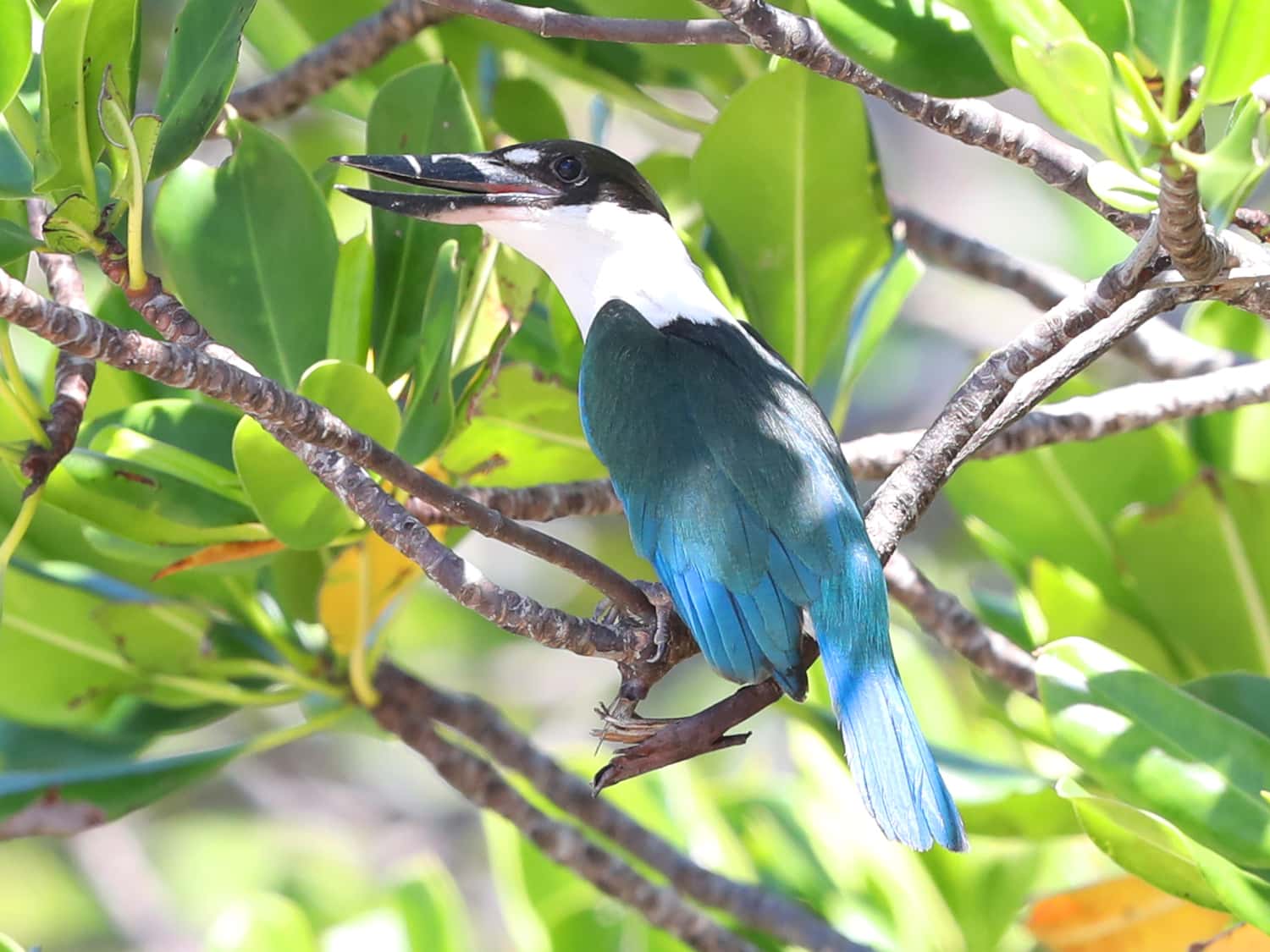
© Birdwatching Tropical Australia
30. Torresian Kingfisher Todiramphus chloris
Resident. Locally common. Coastal mangroves. Low altitude. Year-round. Large greenish kingfisher previously called a Collared Kingfisher. Superficially similar to both the Sacred and Forest Kingfishers but has a larger bill for catching crabs. Can be found in the mangroves at the north end of the Cairns Foreshore (this is also a key site for the Mangrove Robin). Best conditions for viewing is a highish tide so birds are more likely to be on the visible land-side edge of the mangroves rather than the seaward edge. Remember to take protection from the midges. Best Sites: Cairns Foreshore, Centenary Lakes, Redden Island, Jack Barnes Boardwalk. Accommodations: Thala Beach Nature Reserve.
Birds No. 31 – 40
Yellow-breasted Boatbill, Red-footed Booby, Chestnut-breasted Cuckoo, Noisy Pitta, Grass Owl, Double-eyed Fig-parrot, Olive-backed Sunbird, Black-necked Stork, Comb-crested Jacana, Brolga.
Descriptions, Best Sites, Accommodations
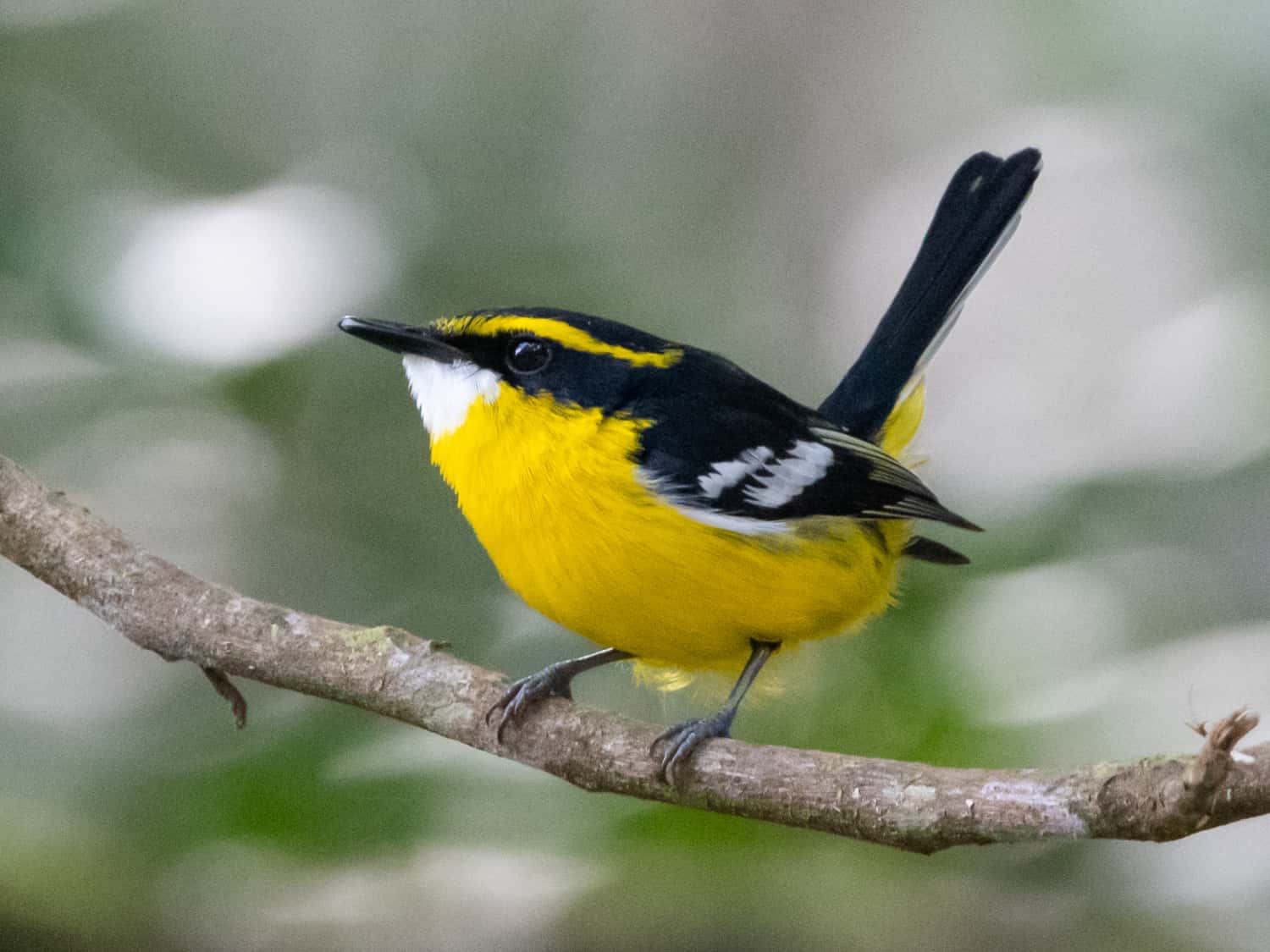
© Cassowary Tours
31. Yellow-breasted Boatbill Machaerirhynchus flaviventer
Resident. Fairly common. Most habitats. Low to mid altitude. Year-round. Delightful, brightly-coloured small bird with a distinctly enlarged flattened bill. Male is predominately black and yellow, whilst the female is a little paler and greener. Generally forages in the mid canopy. Best Sites: Centenary Lakes, Redden Island, Cattana Wetland, Mossman Gorge, Stewart Creek Rd, (base of) Mt Lewis, Black Mountain Rd, Curtain Fig NP, Mt Hypipamee NP, Wongabel SF, Crater Lakes NP, Lacey Creek. Accommodations: Cassowary House, Crater Lakes Rainforest Cottages, Atherton Tablelands Birdwatchers’ Cabins, Sweetwater Lodge, Thala Beach Nature Reserve.
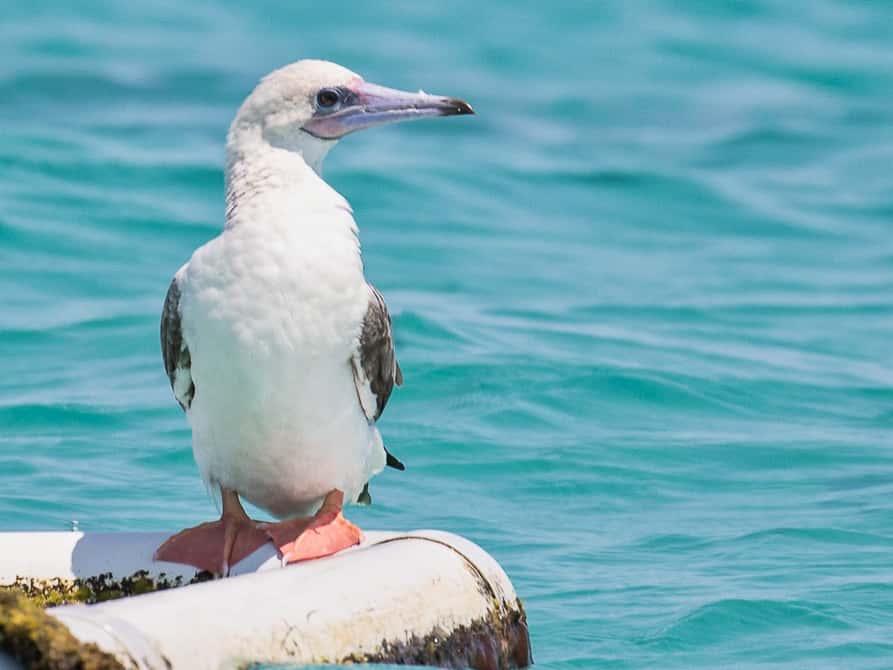
© Tony Neilson, Seastar Cruises
32. Red-footed Booby Sula sula
Vagrant. Offshore sand cays. Best in spring and summer. Regularly turns up at Michaelmas Cay. Often sits on moored tender boats but often disappears soon after passenger boats arrive for the day. Best Sites: Michaelmas Cay (a specialty of Seastar cruises). Accommodations: No accommodations have this bird regularly on site.
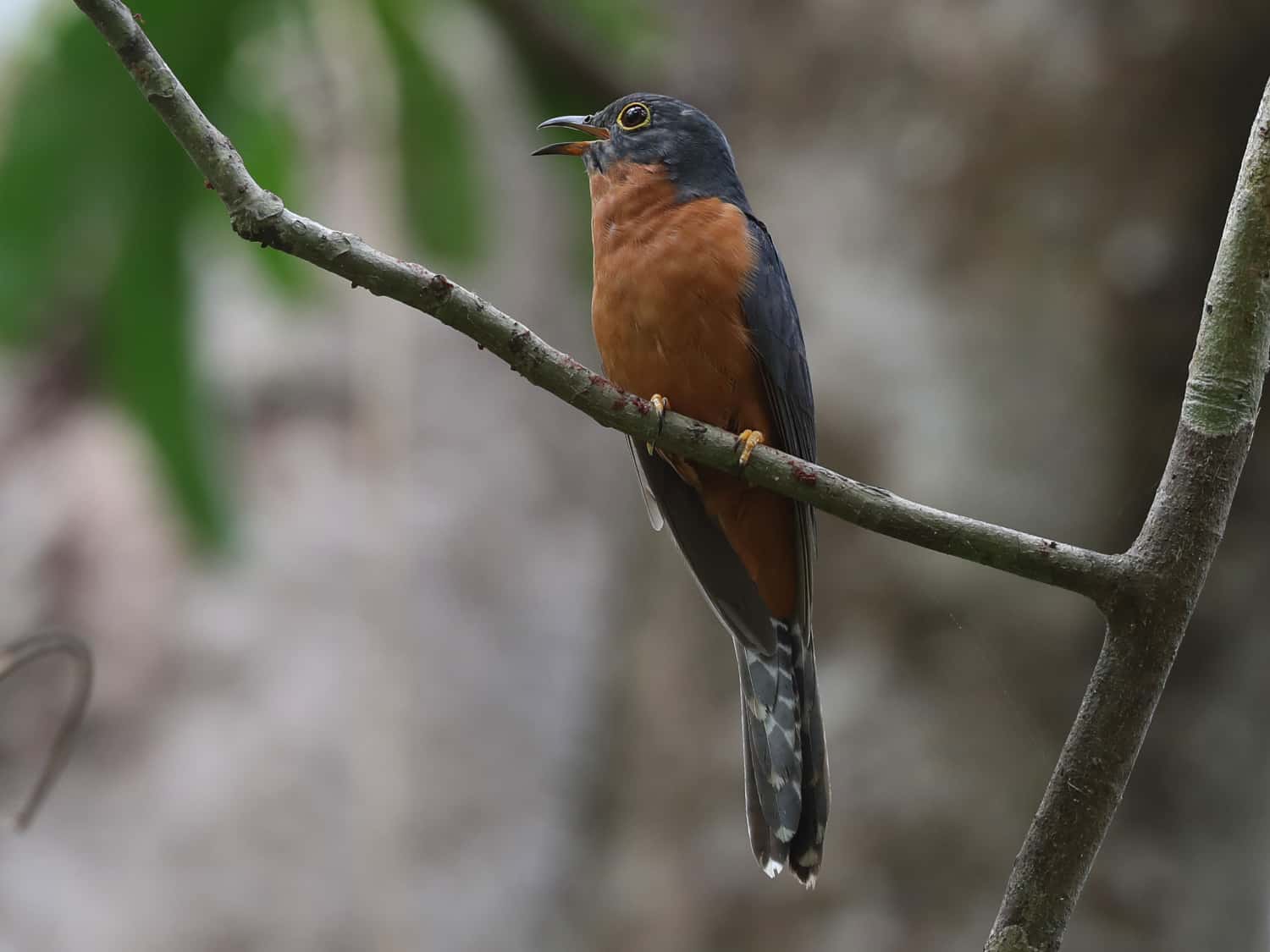
© Birdwatching Tropical Australia
33. Chestnut-breasted Cuckoo Cacomantis castaneiventris
Resident. Uncommon. Rainforest. Mid altitude. Year-round. Can be found most months in rainforest fringe habitat around the Julatten area. Care needs to be taken to separate from the generally paler Fan-tailed Cuckoo. Underside of tail is also different. Best Sites: Mount Lewis (base), Mowbray NP. Accommodations: No accommodations have this bird regularly on site.
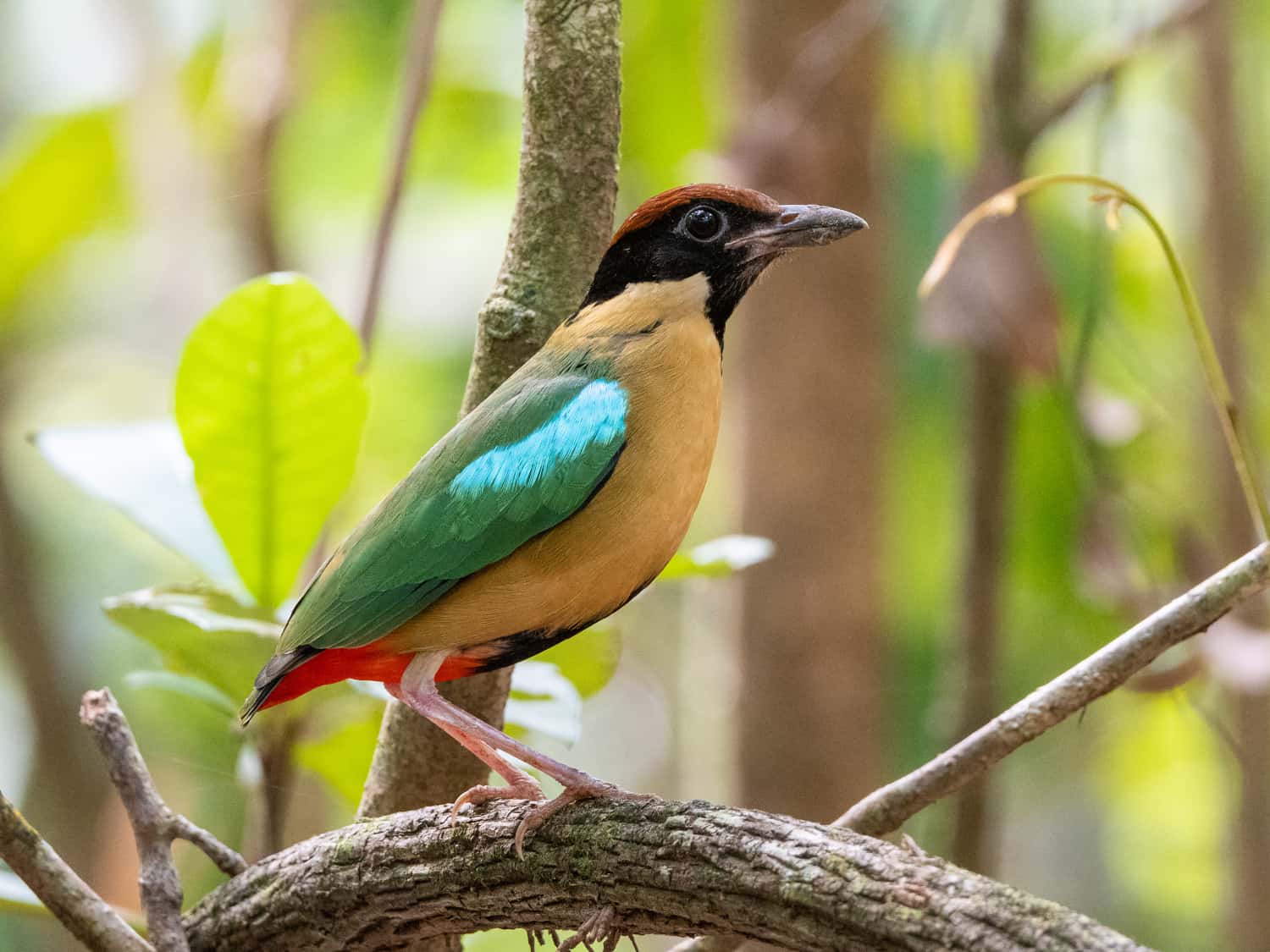
© Cassowary Tours
34. Noisy Pitta Pitta versicolor
Local nomad. Uncommon. Rainforest. All elevations. Easier in spring & summer. Colourful resident of the rainforest floor with a distinctive three-note call ‘walk to work’. Likes to pick through leaf litter for insects and snails. More often heard than seen. Nests during the summer ‘Wet’ on the rainforest floor, often a side entry in a mound of leaves within the buttress of a large tree. Best Sites: Mossman Gorge, Jindalba Boardwalk, Mt Lewis, Black Mountain Rd, Henrietta Creek, Mt Hypipamee NP, Wongabel SF, Curtain Fig NP, Goldsborough Valley. Accommodations: No accommodations have this bird regularly on site.
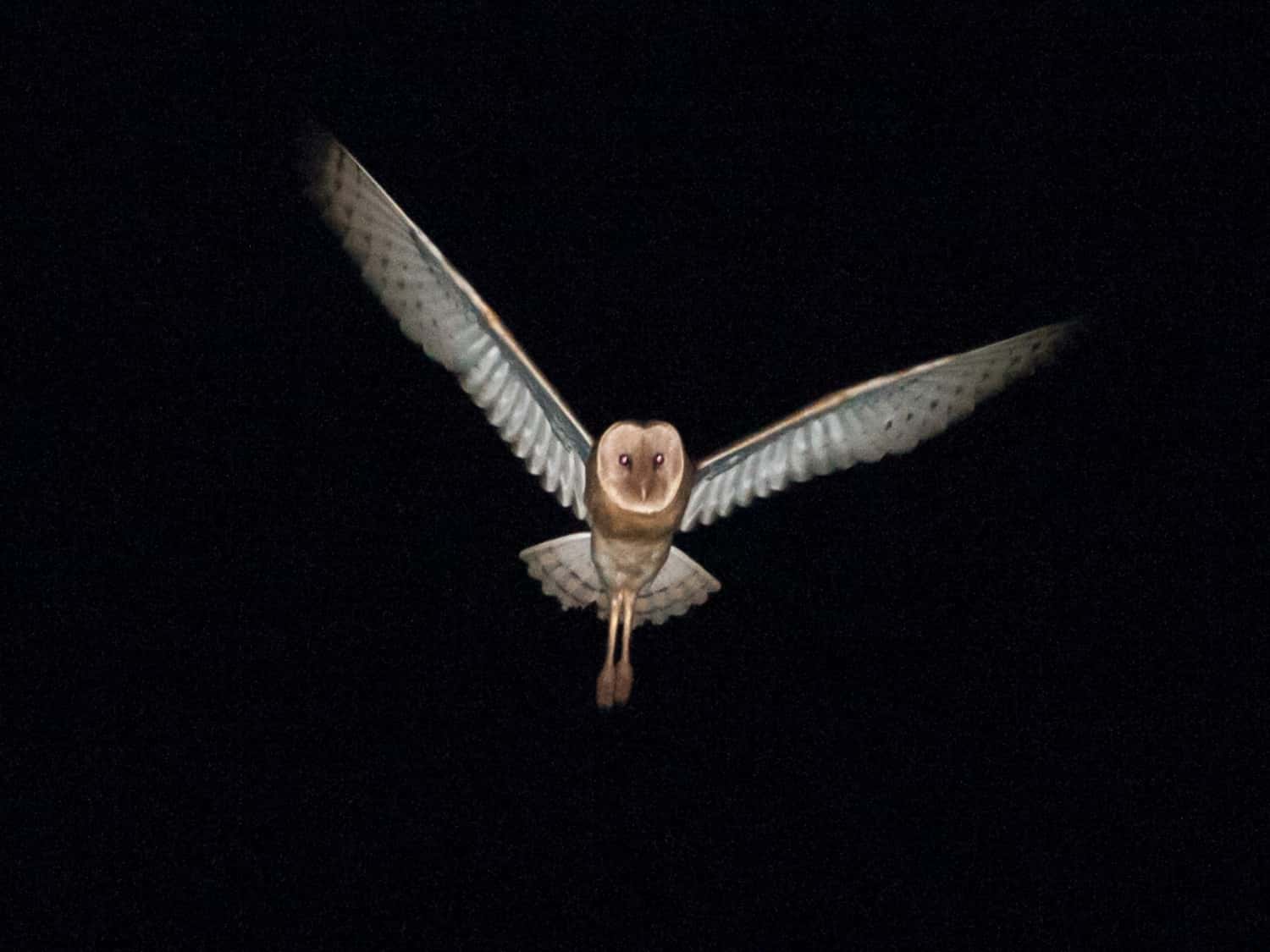
© Cassowary Tours
35. Grass Owl Tyto longimembris
Resident. Uncommon. Grasslands and crops. Mostly higher elevation. Year-round. Can be found most months particularly on country roads on the Atherton Tableland around Yungaburra, particularly in agricultural areas particularly after harvest. Care needs to be taken to separate from Barn Owl. Best Sites: No specific brochure sites. Accommodations: No accommodations have this bird regularly on site.

© Cassowary Tours
36. Double-eyed Fig-parrot Cyclopsitta diophthalma
Local nomad. Common. Rainforest, woodlands, parklands. All altitudes. Year-round. Australia’s smallest parrot. Most often seen flying rapidly overhead. Best method to observe is to watch them fly into a tree in an open area like the Cairns Esplanade and follow to see better. Alternatively look for fruiting fig trees and they may be sitting quietly eating. Listen for falling debris. They excavate a small nesting chamber within soft dead tree trunks and branches. Best Sites: Cairns Foreshore, Centenary Lakes, Pioneer Cemetery, Stewart Creek Rd, Jindalba Boardwalk, Black Mountain Rd, Curtain Fig NP. Accommodations: Sweetwater Lodge, Thala Beach Nature Reserve.
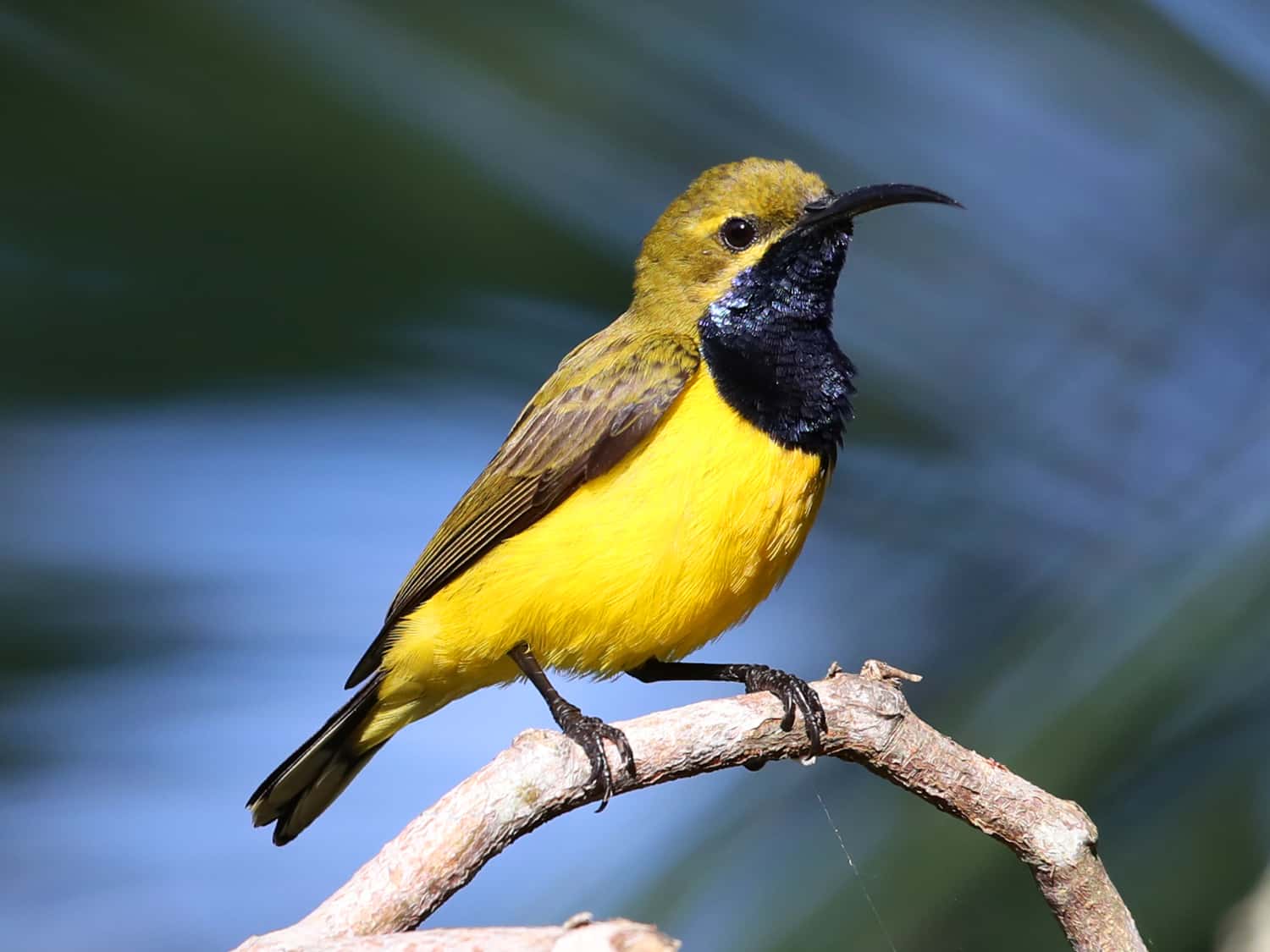
© Birdwatching Tropical Australia
37. Olive-backed Sunbird Nectarinia jugularis
Resident. Common. Rainforest, woodlands, parklands. Low to mid altitude. Year-round. Australia’s sole sunbird species. Small bird with a bright yellow breast and olive-coloured wings. Male has an additional black shiny blue patch on the chest. Build a distinctive tear-drop nest often hanging from a man-made structure including bus-stops and verandas. Should easily be observed foraging on flowers for nectar. Best Sites: Cairns Foreshore, Centenary Lakes, Flecker Botanical Gardens, Pioneer Cemetery, Daintree Village, Stewart Creek Rd, Abattoir Swamp, Mount Molloy, Emerald Creek. Accommodations: Sweetwater Lodge, Thala Beach Nature Reserve, Cassowary House, Villa Marine Apartments.

© Nevil Lazarus, Daintree Boatman Cruises
38. Black-necked Stork Ephippiorhynchus asiaticus
Resident. Uncommon. Wetlands, rivers, coast. Low to mid altitude. Year-round. Australia’s sole stork species. Unmistakable. Sparsely distributed throughout the wetlands of the region. Male has a black eye whilst the female has a yellow eye. Tend to nest mid-year, often fledging 2 or 3 offspring. On Daintree River cruises, sightings are more common in the second half of the year. Best Sites: Cairns Foreshore, Centenary Lakes, Cattana Wetlands, Yule Point, Wonga Beach, Daintree Village (specialty of Daintree River boat cruises), Stewart Creek Road, Abattoir Swamp, Lake Mitchell, Eubenangee Swamp NP. Accommodations: No accommodations regularly have this bird on site.
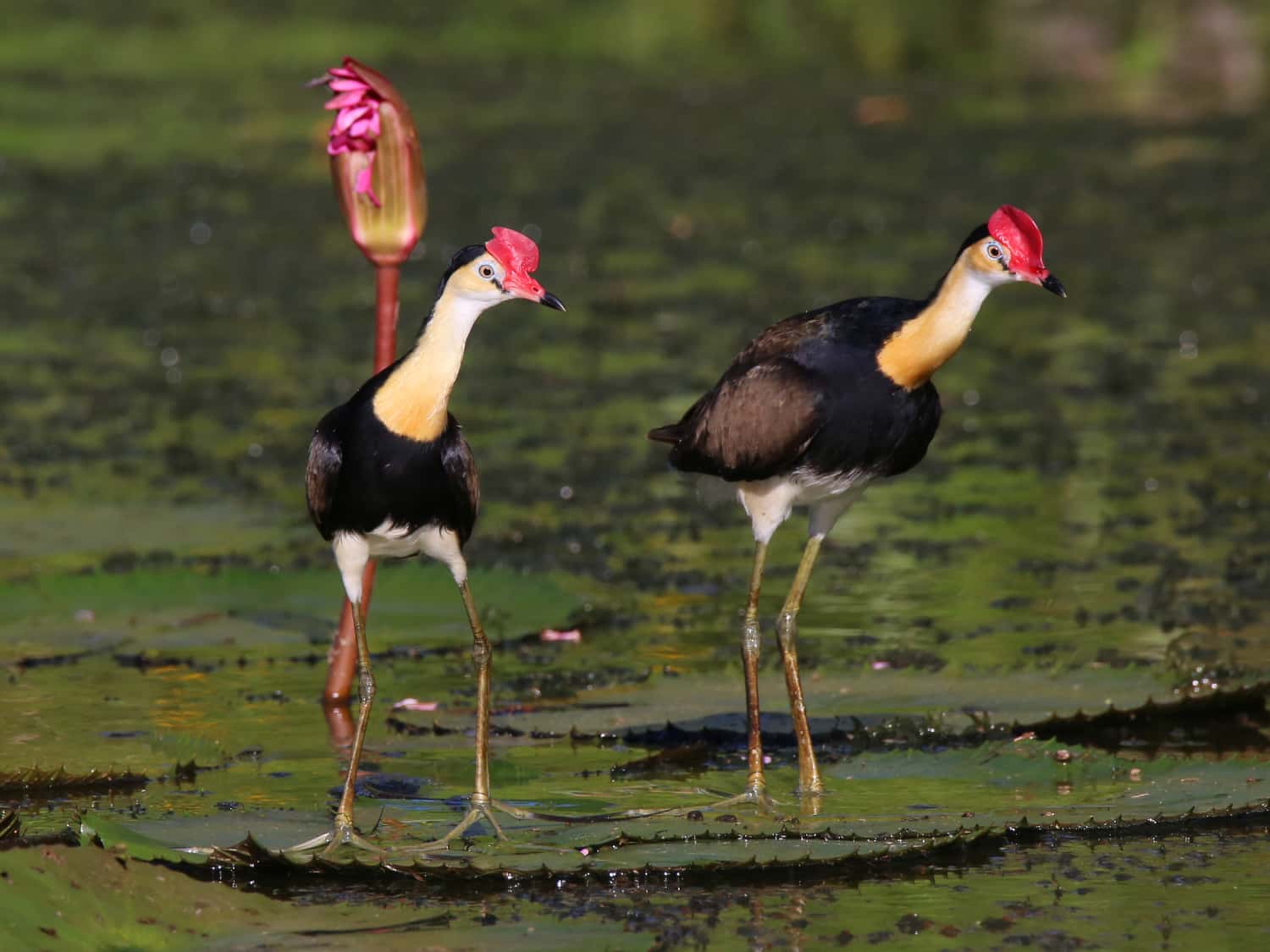
© Birdwatching Tropical Australia
39. Comb-crested Jacana Irediparra gallinacea
Resident. Uncommon. Wetlands. All altitude. Year-round. Australia’s sole jacana species. Sparsely distributed throughout the wetlands of the region. Polyandrous. Female is larger and more brightly-coloured whilst the more subtly-coloured male does the incubation and raising of chicks. Best Sites: Centenary Lakes, Cattana Wetlands, Lake Mitchell, Hasties Swamp, Eubenangee Swamp. Accommodations: No accommodations have this bird regularly on site.
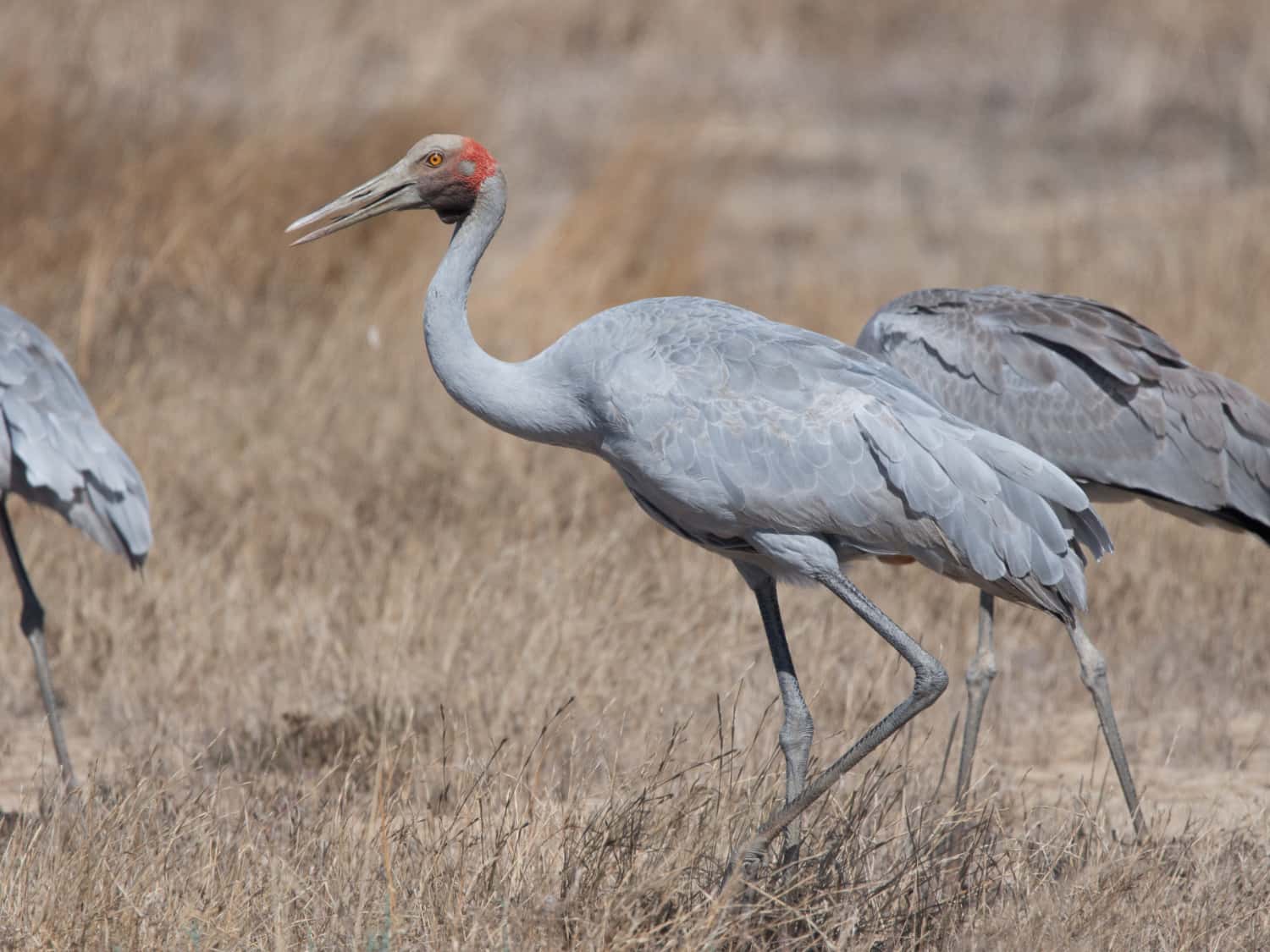
© Cassowary Tours
40. Brolga Grus rubicunda
Seasonal migrant. Uncommon. Wetlands and fields. Mostly mid to high altitude. Winter & spring. Present in the Wet Tropics from June to October. Often seen in mixed groups with Sarus Cranes foraging on agricultural fields or coming to roost at wetlands particularly Bromfield Swamp. Disperses about October to breed in Gulf Country. Best Sites: Lake Mitchell, Mareeba Wetlands, Tinaroo Creek Road, Hasties Swamp, Bromfield Swamp as well as fields on the Atherton Tableland. Accommodations: No accommodations have this bird regularly on site.
Birds No. 41 – 50
Black-throated Finch, Barking Owl, Australian Bustard, Red-tailed Black-cockatoo, Red-necked Crake, Pale-vented Bush-hen, Squatter Pigeon, Shining Flycatcher, Superb Fruit-dove, Rose-crowned Fruit-dove.
Descriptions, Best Sites, Accommodations
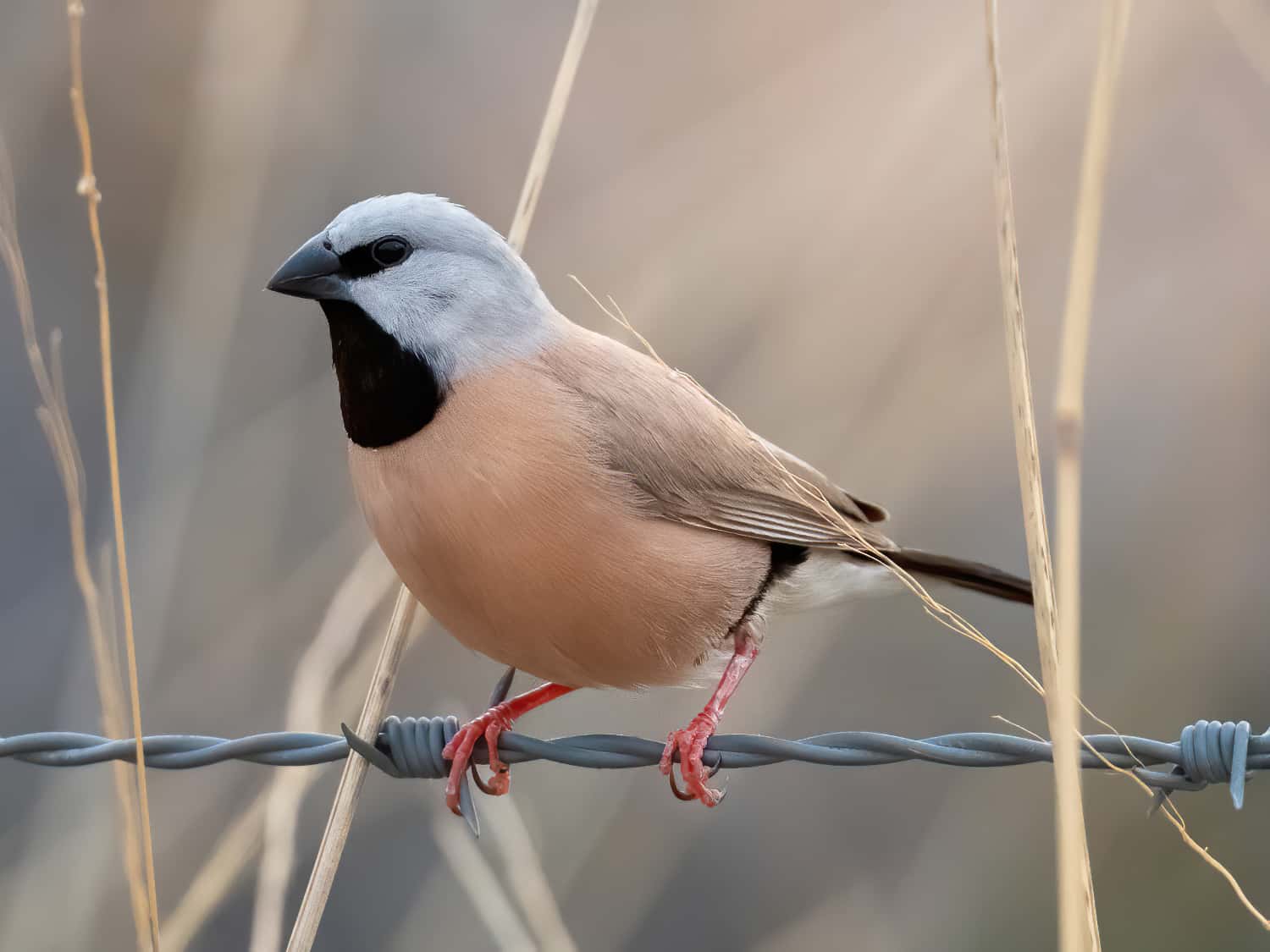
© Cassowary Tours
41. Black-throated Finch Poephila cincta
Local nomad. Uncommon. Dry country. Mid altitude. Year-round. Sparsely distributed dry country finch. Lovely subdued colours. The local northern subspecies (atropygialis) has a black rump whilst the endangered southern subspecies (cincta) – regularly in the news lately due to a mine proposal – has a white rump. Best Sites: Pickford Rd (uncommon). Accommodations: No accommodations regularly have this bird on site.
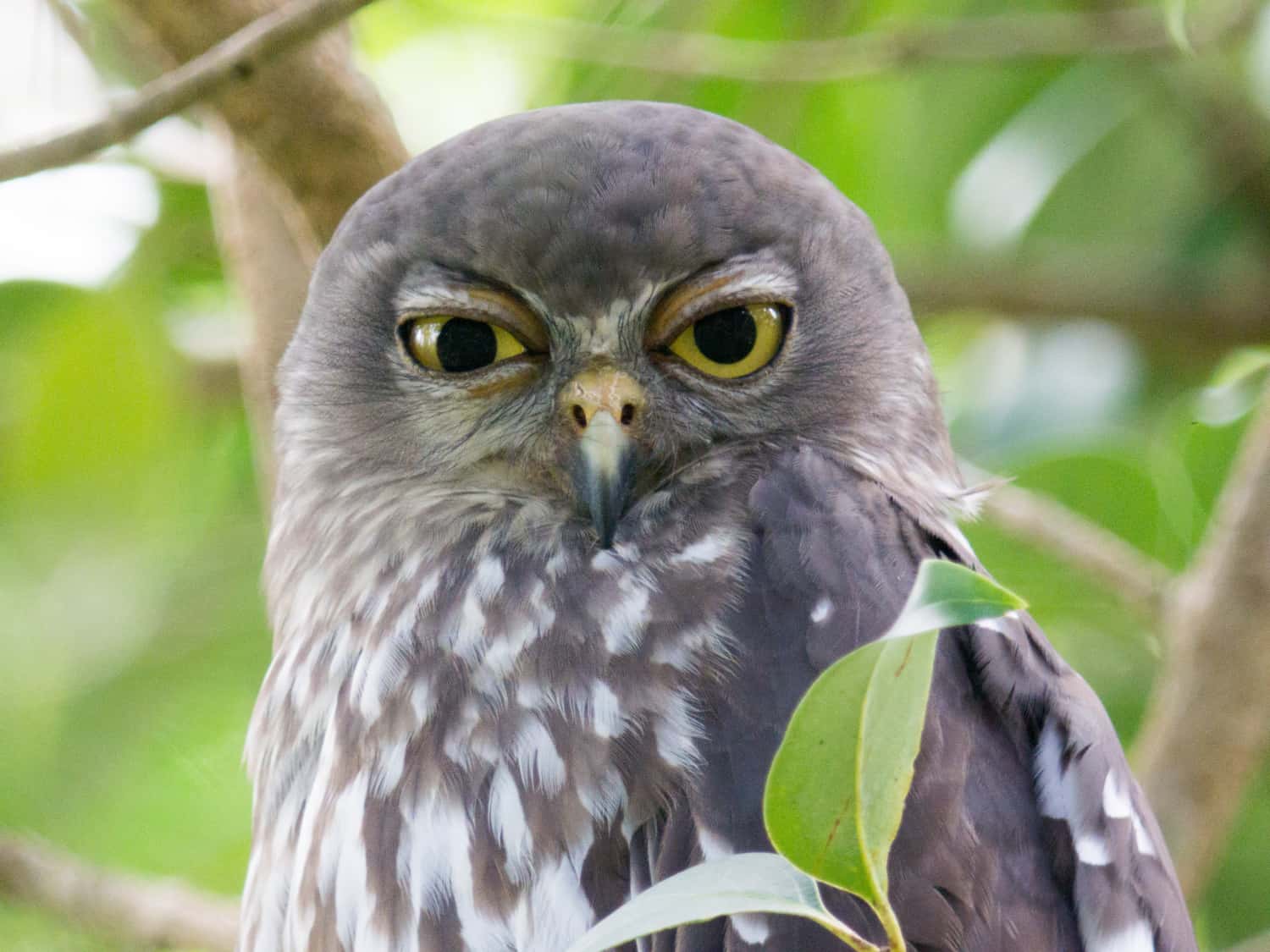
© Cassowary Tours
42. Barking Owl Ninox connivens
Local resident. Locally common. Sclerophyll & rainforest margins. Mid to high altitude. Year-round. Largish speckled brown owl with bright yellow eyes and an unmistakable dog-like ‘wook wook’ call. May sit on fenceposts or signposts along roads after dark particularly in rural areas. Best Sites: Maryfarms, Pickford Rd, Tinaroo, Hasties Swamp, Pelican Point. Accommodations: No accommodations have this bird regularly on site.
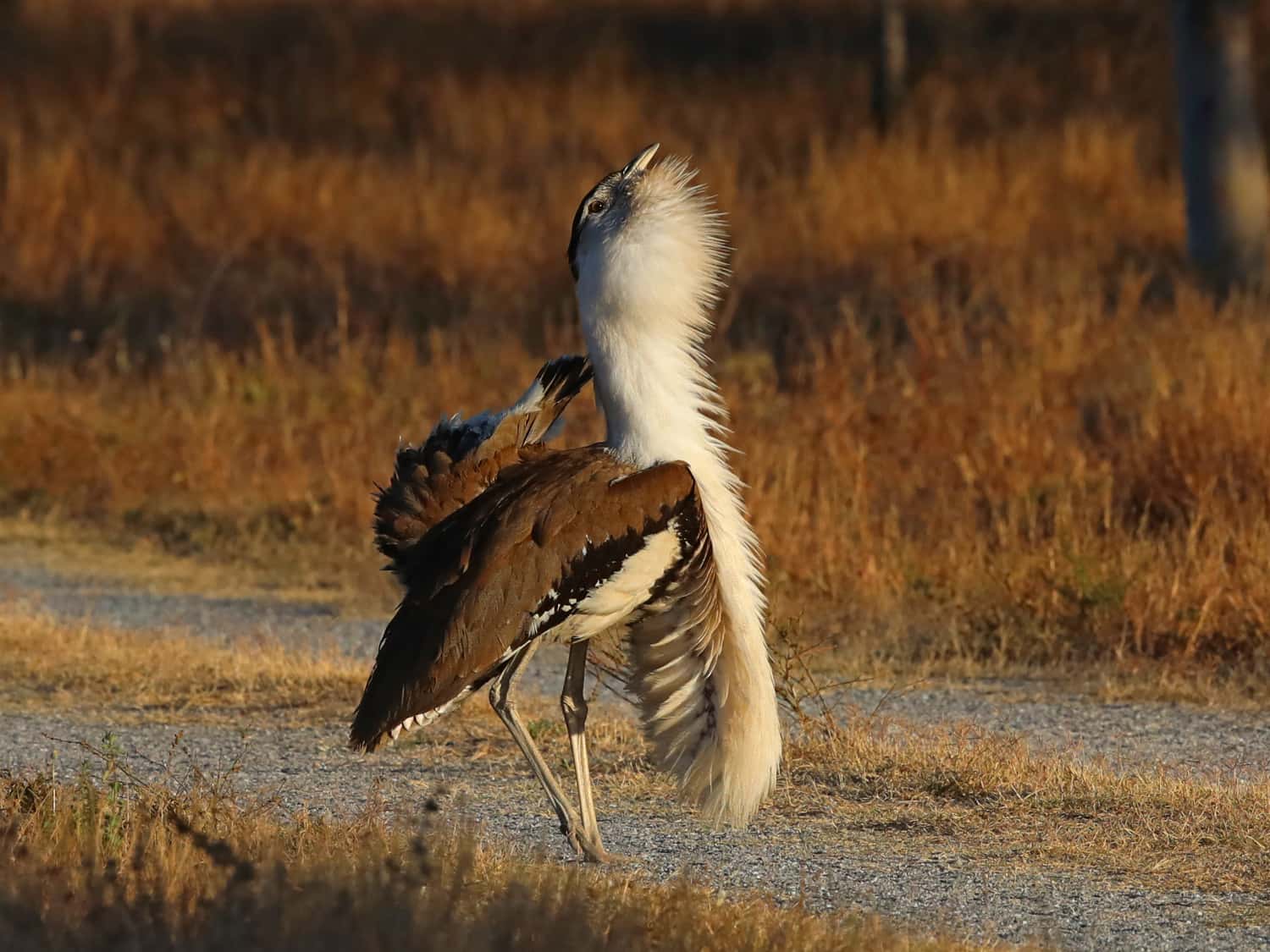
© Birdwatching Tropical Australia
43. Australian Bustard Ardeotis australis
Local nomad. Locally common. Dry country. Mid altitude. Year-round. Distinctive, stately bird, more usually found in the drier western area but occasionally found in the coastal region. Usually found foraging for insects through long native grasses, particularly around Maryfarms. Occasionally seen in unusual areas immediately after cane harvest to forage for dead insects. Particularly in spring, males may be observed displaying with a vertically fanned tail and a long pendulous inflated breast sac. Call is a deep exhalation of air, somewhat like a distant lion. Best Sites: Maryfarms, Pickford Rd, Tinaroo Creek Rd. Accommodations: No accommodations regularly have this bird on site.
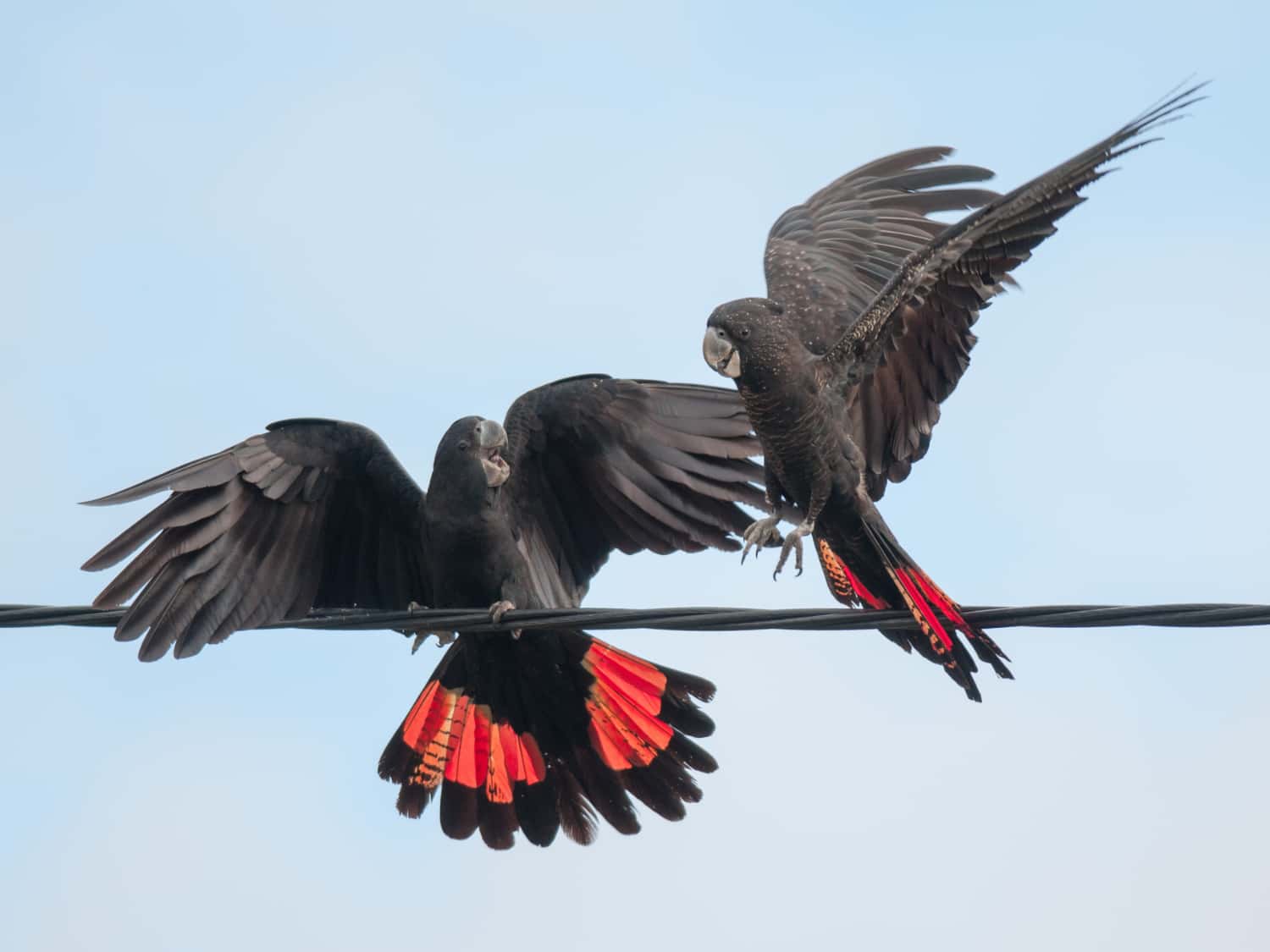
© Cassowary Tours
44. Red-tailed Black-cockatoo Calyptorhynchus banksii
Seasonal migrant. Locally common. Dry country and beaches. Mid to low altitudes. Year-round. Historically more likely encountered in the drier western region, more recently a population has taken up residence in the northern beaches of Cairns. In the western area, they can often be found just south of Mareeba (along the highway between Mareeba and Atherton). Members of the coastal population can sometimes be seen roosting on lightposts along the highway particularly around the roundabouts for the northern beaches of Cairns. Best Sites: No specific brochure sites. Accommodations: No accommodations regularly have this bird on site.
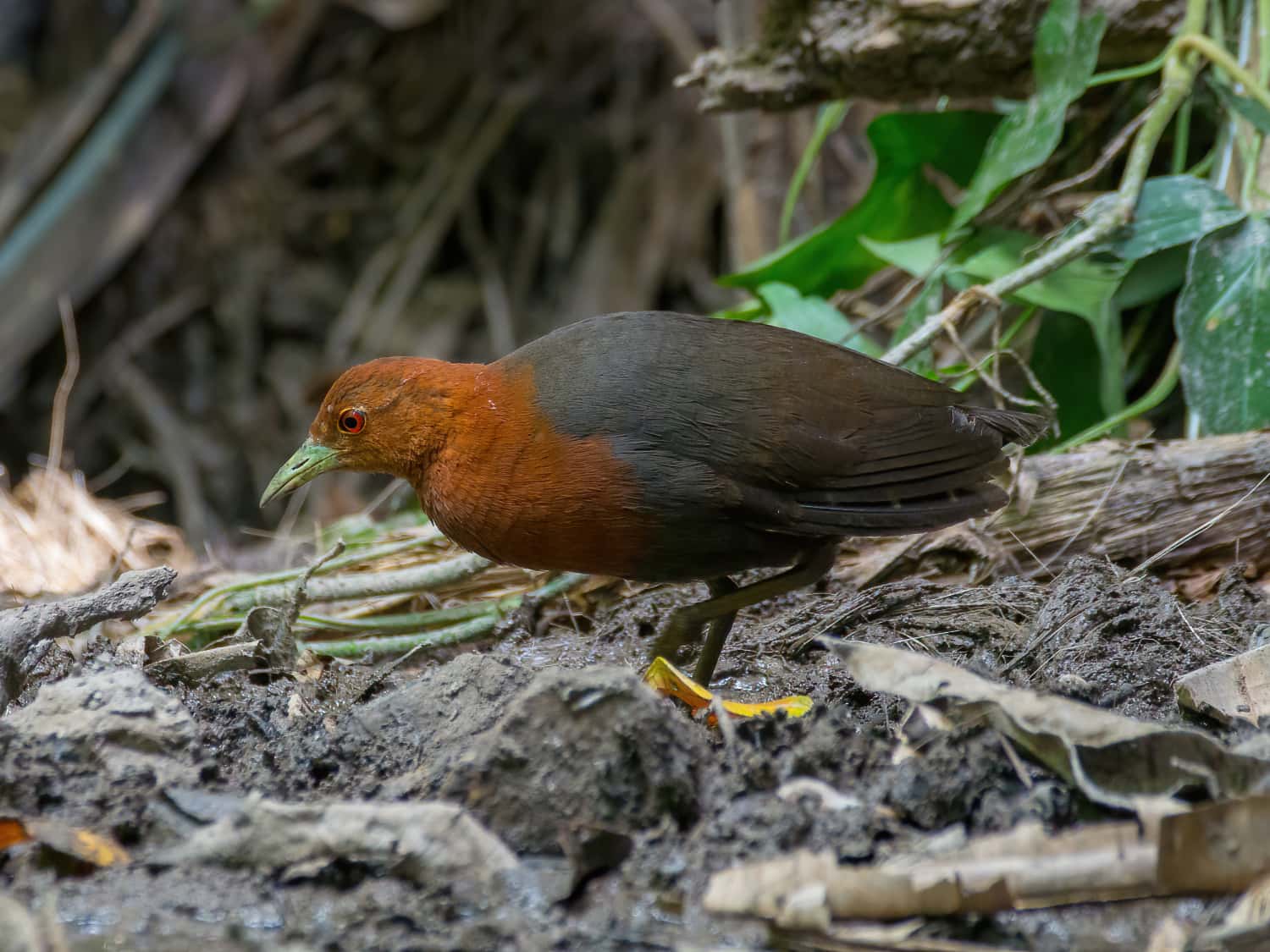
© Cassowary Tours
45. Red-necked Crake Rallina tricolor
Presumed resident. Uncommon. Rainforest & wet areas. All altitudes. Easier in spring & summer. Difficult-to-see skulker, rarely seen well. Sometimes becomes tame and more visible at rainforest accommodations. More likely to be observed in late Spring and early Summer. Best Sites: Centenary Lakes, Flecker Botanical Gardens, Stewart Creek Rd, Daintree Village (infrequently seen on Daintree River cruises). Accommodations: Crater Lakes Rainforest Cottages, Cassowary House.
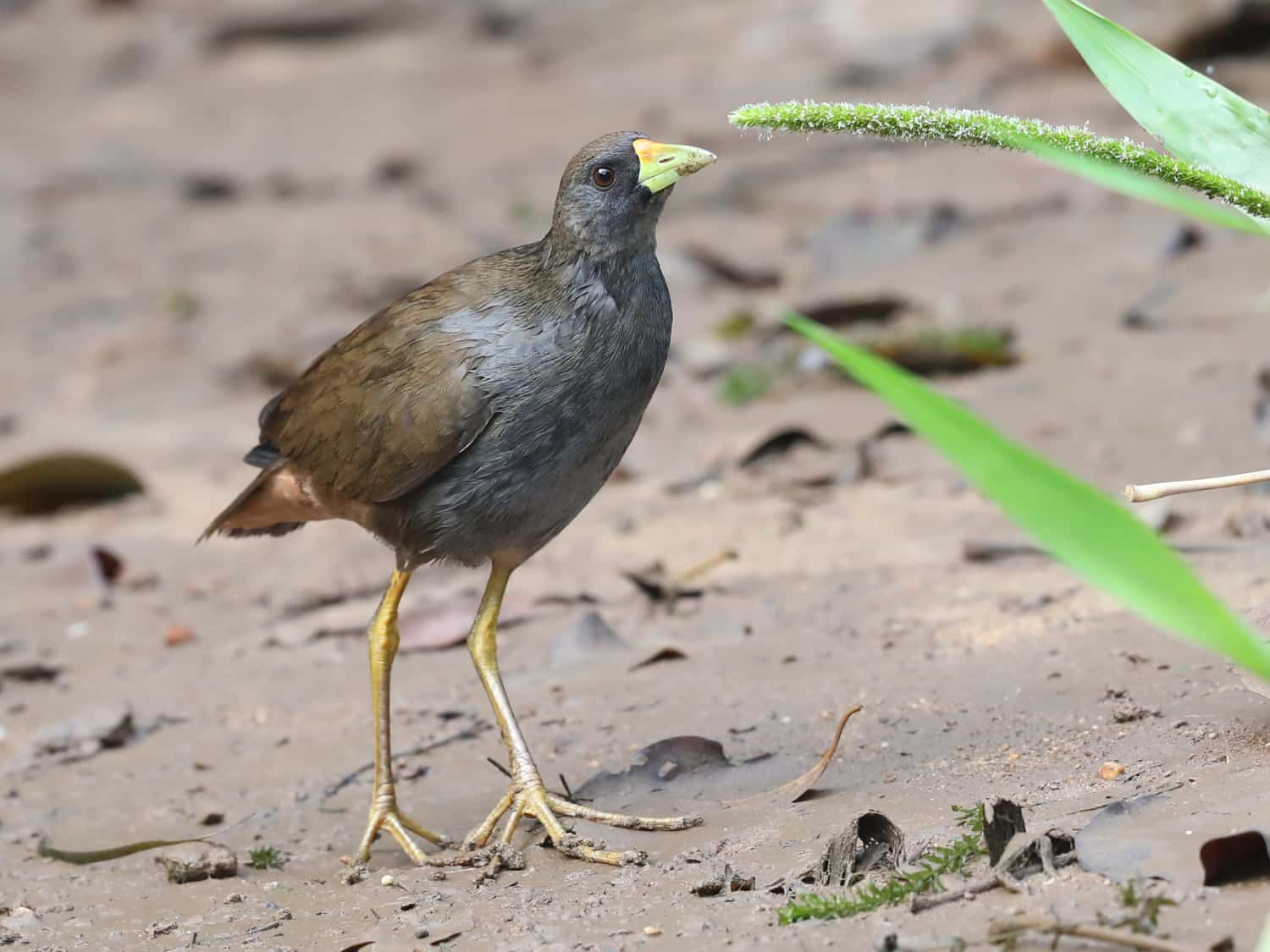
© Birdwatching Tropical Australia
46. Pale-vented Bush-hen Amaurornis moluccana
Presumed resident. Uncommon. Rainforest & wet areas. All altitudes. Easier in spring & summer. Difficult-to-see skulker, rarely seen well. Can be seen most months but more likely in late spring and early summer. Tends to be more active and visible on overcast days, particularly with some drizzle. Best Sites: Hasties Swamp, Stewart Creek Rd, Steward Creek Rd, Daintree Village (infrequently seen on Daintree River cruises). Accommodations: Sweetwater Lodge.
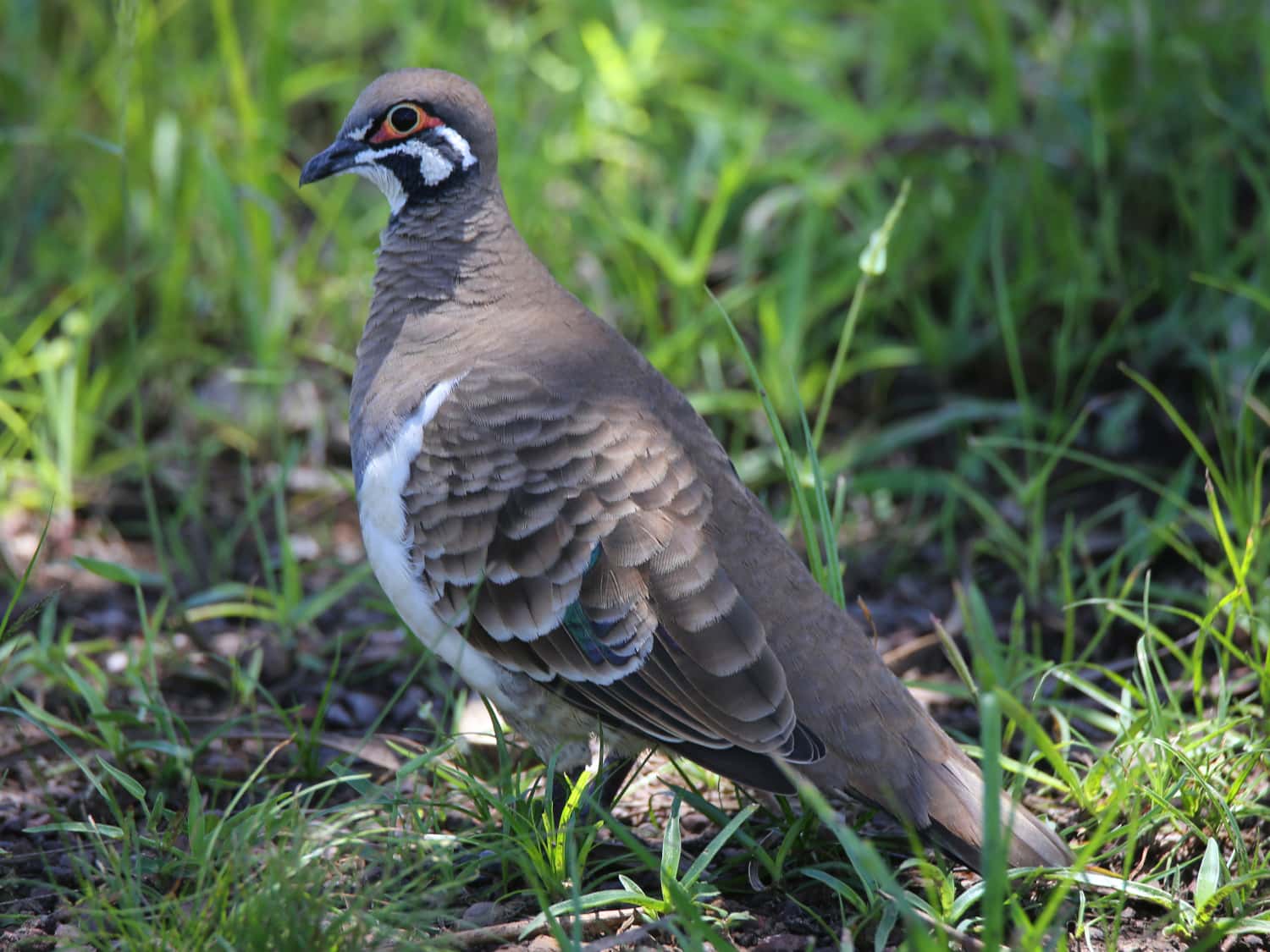
© Birdwatching Tropical Australia
47. Squatter Pigeon Geophaps scripta
Resident. Uncommon. Dry country. Mid altitude. Year-round. Delightful ground-dwelling pigeon. Very comfortable on the ground, squats to hide when threatened, flies when pressed. Subdued delicate earthen colours with bolder pattern on head. Usually found foraging for seeds in short dry grasses, usually in small family parties of up to a dozen. A good site for this species is the campground at Granite Gorge. Best Sites: Mt Molloy, Tinaroo Creek Rd, Emerald Creek. Accommodations: No accommodations regularly have bird on site.
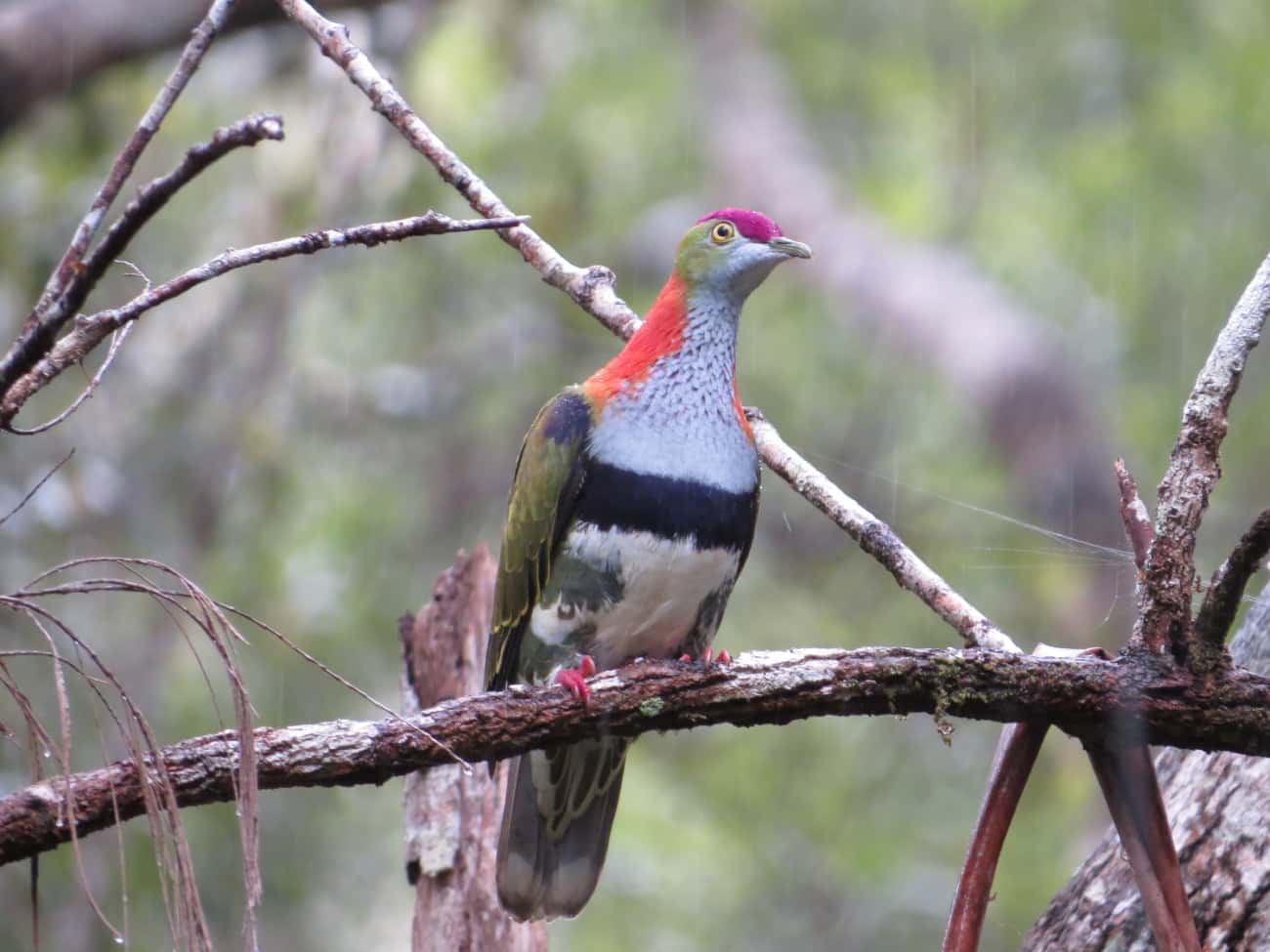
© Atherton Tablelands Birdwatchers' Cabin
48. Superb Fruit-dove Ptilonopus superbus
Resident. Uncommon. Rainforest. All altitudes. Year-round. Elusive. Superbly-coloured small pigeon. Can be solo or in small parties. Difficult to observe well unless found nesting or feeding on a fruiting tree that includes mangroves, lantana, figs, pittosporums, lilly pillies and laurels. Can be located by falling fruit. Call is a half dozen of fairly evenly spaced deep ‘whoops’. Best Sites: Crater Lakes NP, Curtain Fig NP. Accommodations: Atherton Tablelands Birdwatchers’ Cabin, Crater Lakes Rainforest Cottages, Thala Beach Nature Reserve.
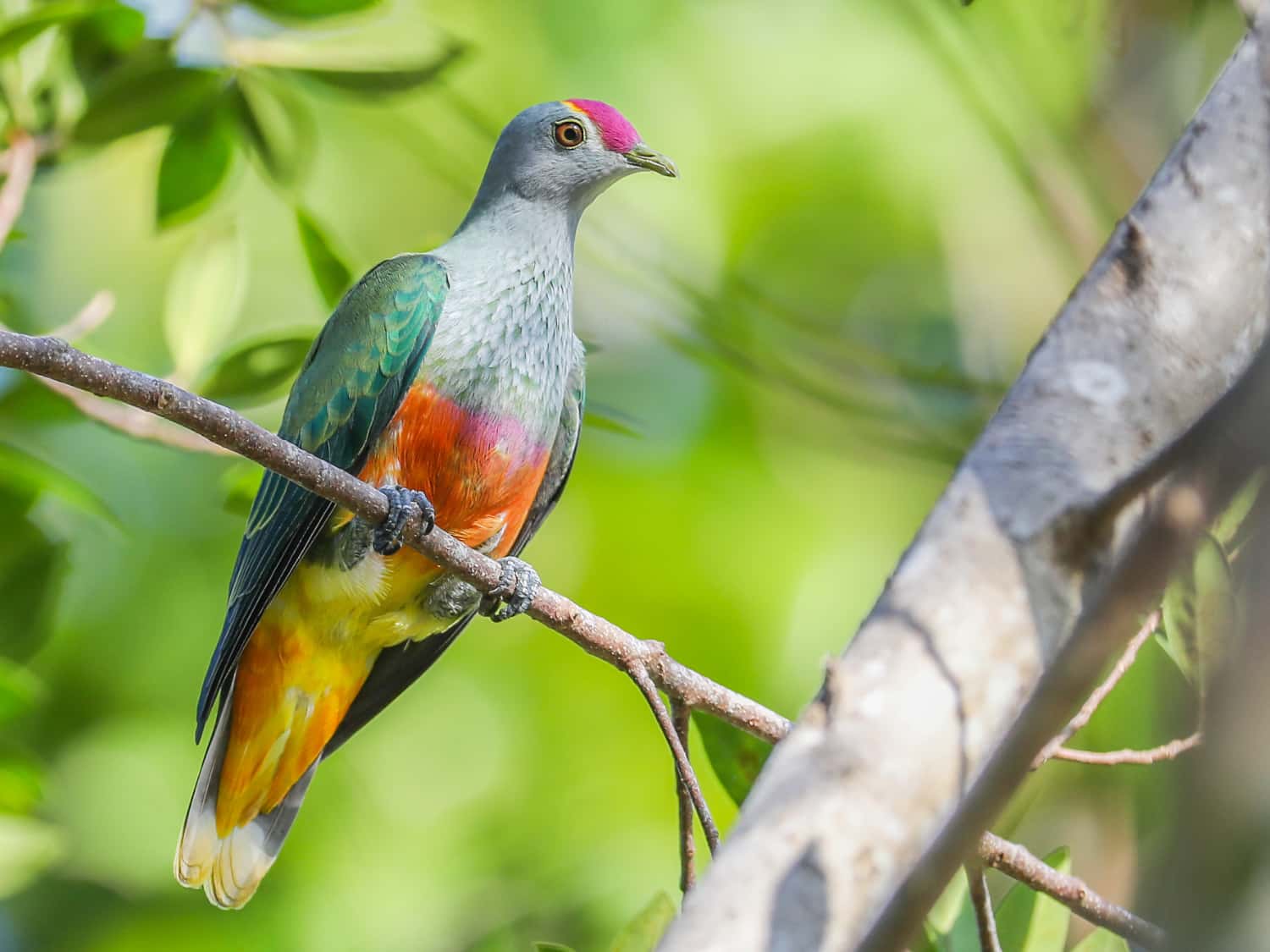
© Dom Chaplin
49. Rose-crowned Fruit-dove Ptilonopus regina
Resident. Uncommon. Rainforest and more open habitat. All altitudes. Year-round. Elusive. Superbly-coloured small pigeon. Difficult to observe well unless found nesting or feeding on a fruiting tree. They are more likely than the Superb Fruit-dove to be found out of the closed forest feeding in more open areas including coastal vine thickets, orchards and gardens. Can be located by falling fruit. Call accelerates, ending in a staccato ‘coo-coo-coo’. A good site for this species is Green Island. Best Sites: Crater Lakes, Curtain Fig, Cairns Foreshore, Flecker Botanical Garden, Newell Beach. Accommodations: Atherton Tablelands Birdwatchers’ Cabin, Crater Lakes Rainforest Cottages, Thala Beach Nature Reserve.
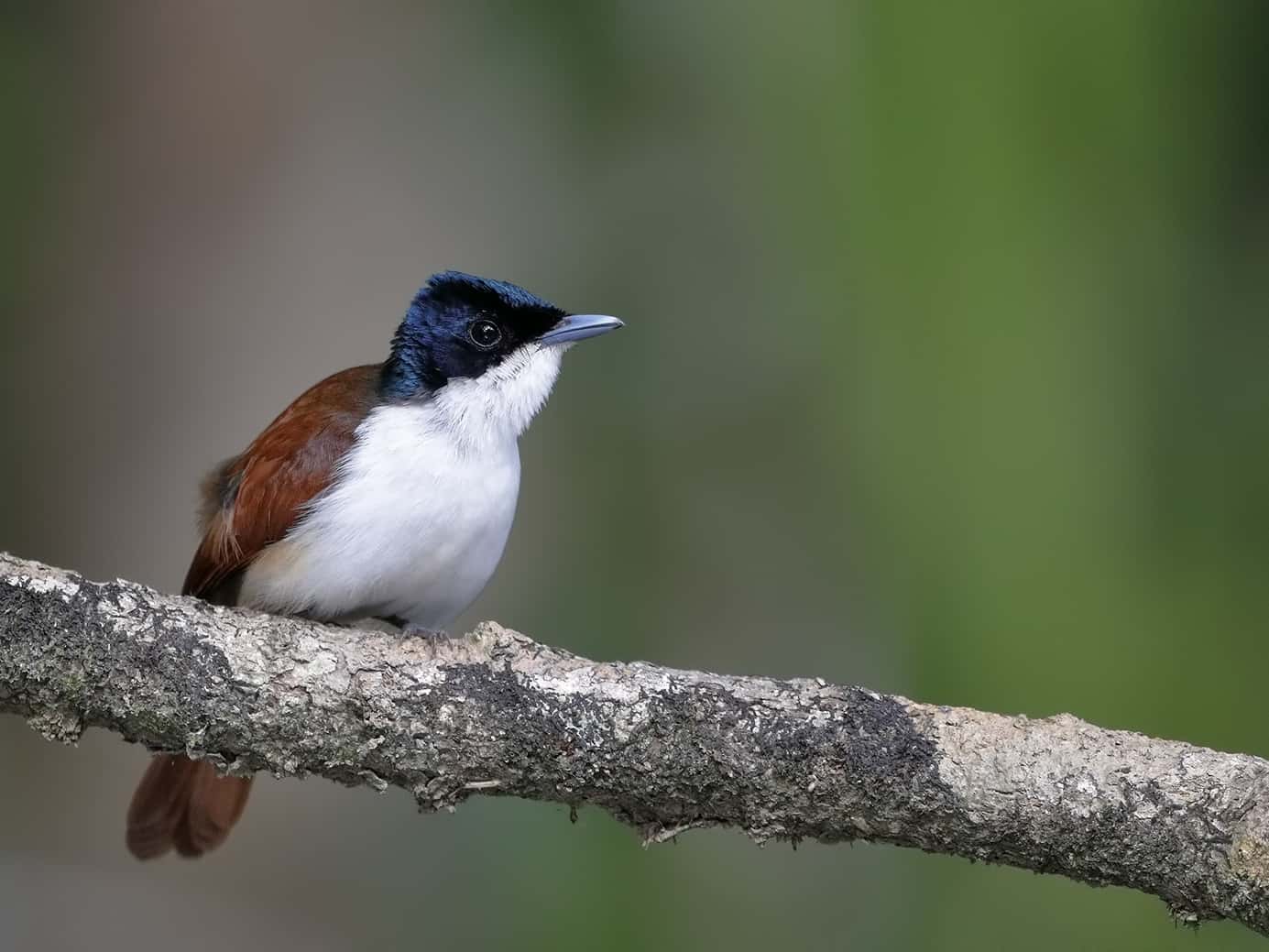
© Doug Castle, Daintree Boatman Cruises
50. Shining Flycatcher Myiagra alecto
Resident. Locally common. Creeks and rivers. Low altitude. Year-round. Pretty, sexually-dimorphic flycatcher. Females are rusty brown and white with a black cap. The male is completely black, shiny blue in sunlight. Most often seen foraging for insects along the edge of water. In tidal areas, including Daintree River, they are more visible on lower tides. Best Sites: Cattana Wetlands, Redden Island, Jack Barnes Boardwalk, Daintree Village (a specialty of Daintree River cruises). Accommodations: Thala Beach Nature Reserve.
